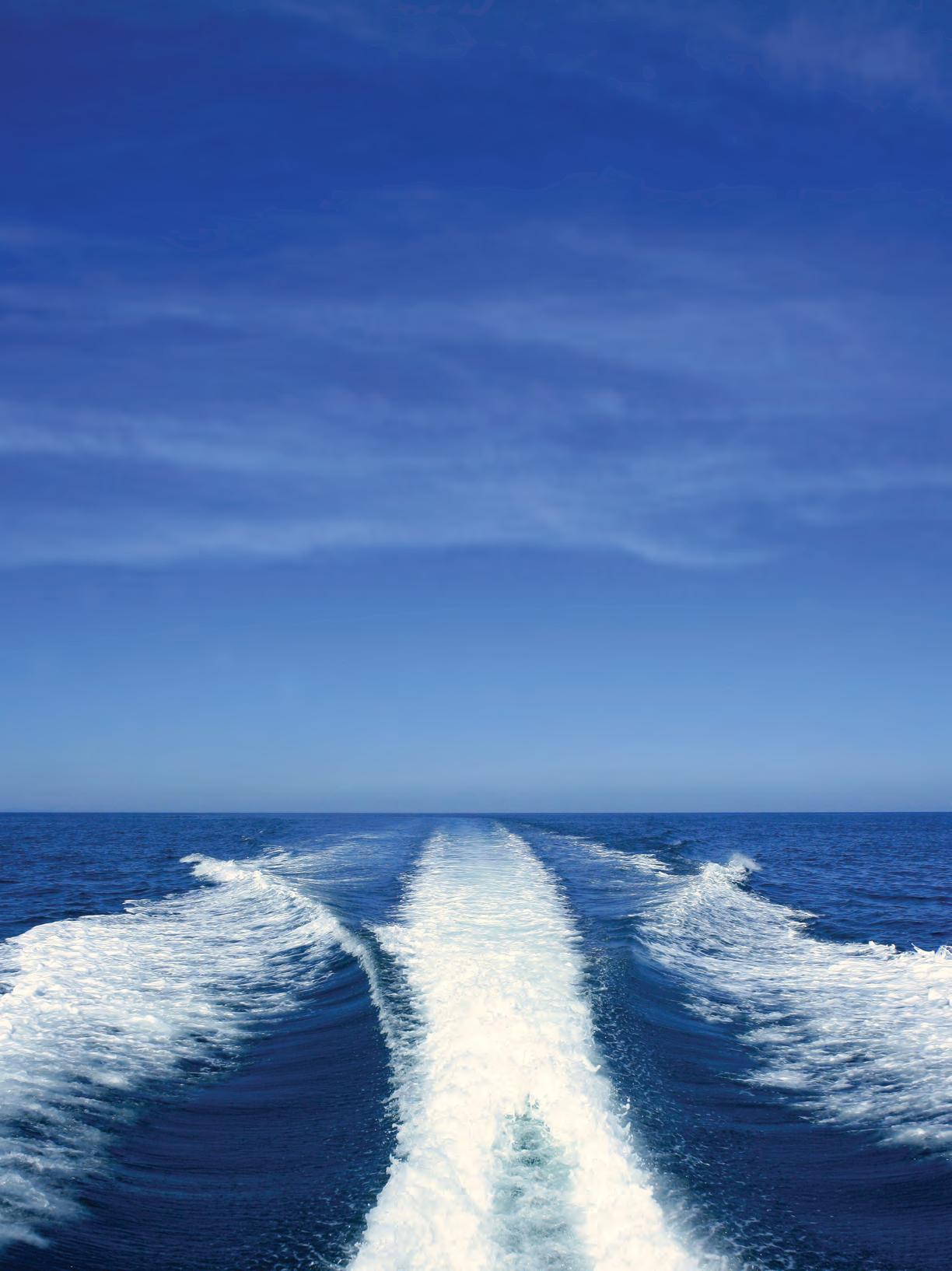








Dear Angler,

Are you looking for a change in the New Year? We have plans to expand in 2023 and are seeking like-minded outdoor enthusiasts who share in our vision to bring our free publication to every town in America!
Do you want to work from home, be your own boss, and control your time and earnings? Then owning your own fishing magazine may be right for you!


Our ideal candidate for this unique business opportunity:
• Loves the Outdoors
• Loves Meeting People
• Has Prior Business Experience or at Least Three Years of Sales Experience


• Has Good Credit & Driver’s License


• Is a Self-Starter

If you or someone you know is looking for an opportunity to own their own home-based business and earn a living in the outdoor industry, please contact us at 321.777.2773 x 1 or email info@coastalanglermagazine.com.

Ask us if we have a franchise territory available near you! We have freshwater and saltwater franchise territories available throughout the US and abroad!
Ben Martin Editor In Chief
With a combined national readership of over a million per month and distribution to over 11,000 businesses in four regions, Coastal Angler Magazine and The Angler Magazine are the preferred resources for anglers and outdoor enthusiasts. Our brand is well known throughout the fishing world, and our free monthly magazines are recognized as well-designed, thoughtful publications that provide newsworthy and entertaining information pertinent to the marine and fishing industries.
Be in Business For Yourself...But Not By Yourself. An exceptionally rewarding and fulfilling business opportunity, as a co-publisher of your area’s Coastal Angler or The Angler Magazine, you’ll enjoy the benefits of controlling your own time and future. Our proven franchise publishing system enables individuals with no prior publishing experience to publish a credible and profitable localized version of our award winning magazine. We provide complete training and on-going support to ensure your success.
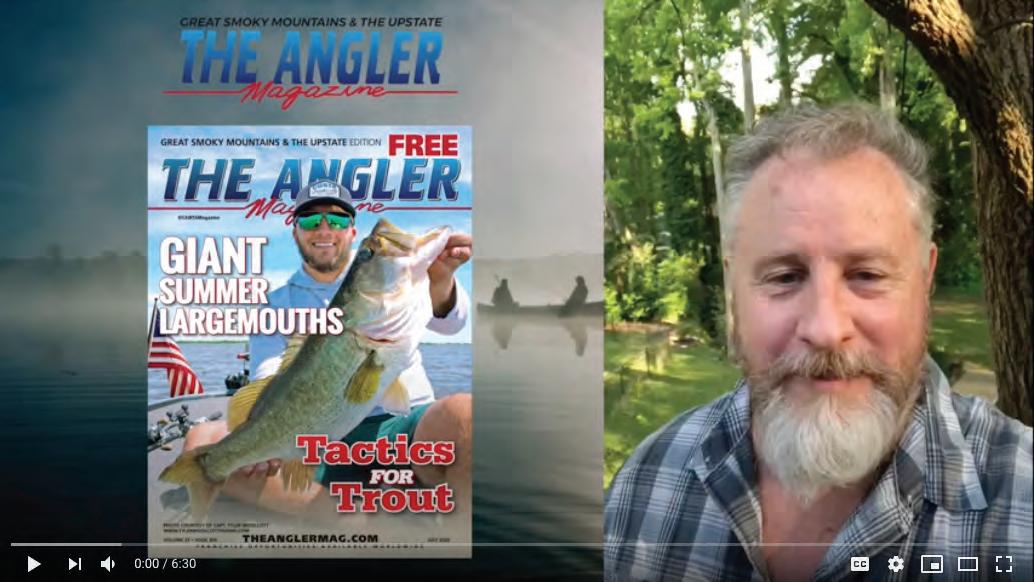




Understanding the importance of fostering a meaningful relationship with the world around us, Yamaha’s new Run the Water video series delves deep into the ocean’s natural beauty and the people who seek to explore its depths. Examining what pushes us to discover a different side of the water allows for a truly unique experience, whether you are a seasoned enthusiast or curious first timer.
In Run the Water’s first chapter, “Above and Below,” viewers are invited to join two lifelong explorers behind-the-scenes and learn why their passion for water runs deeper than you can imagine. A close and personal look at the breathtaking visuals quickly enhances the messaging of why it is vital to take care of the waters we rely on.
“At Yamaha, we’re passionate about encouraging people to responsibly discover their own sense of adventure whether on land or at sea,” said Leslie Zlotnick, Marketing Division Manager of Yamaha WaterCraft. “We believe it is our job to inspire others to appreciate and respect the environment where we live and play, we can do that by sharing the powerful and unique stories that arise from the bodies of water we cherish.”
Professional angler, Natalie Dillon and spear fishing guide, Peter Correale, lead us on an offshore fishing expedition while they share their candid love for the ocean and the unparalleled experiences that come along with it.
Above and Below offers an exclusive look at life at sea, and an opportunity to get inside the minds of two true adventurers. While the stars of the show share their personal triumphant journeys, including Natalie turning one of her biggest fears into a lifelong passion and Peter explaining the crucial skills needed to be a successful spear fisher, audiences are treated to compelling underwater footage of sea life and thrilling
shots of these professionals in action.
Although this is just the beginning, Yamaha’s message surrounding why the waters we play in are as essential as the air we breathe, is crystal clear. All it takes is a dip beneath the surface.
Following an exciting and educational chapter one, fans of the brand can look forward to another meaningful video in Chapter Two, “The Worlds Aquarium.” Viewers will have the opportunity to meet Gádor Muntaner and Rafael Fernandez Caballero, a dynamic team who is making outstanding contributions to conserving the creatures that call the waters of Baha, California home.
Yamaha is excited to introduce the official Run the Water webpage, https://www.yamahaboats. com/run-the-water, where users can check-out the latest Run the Water video series content to ensure they never miss an episode.


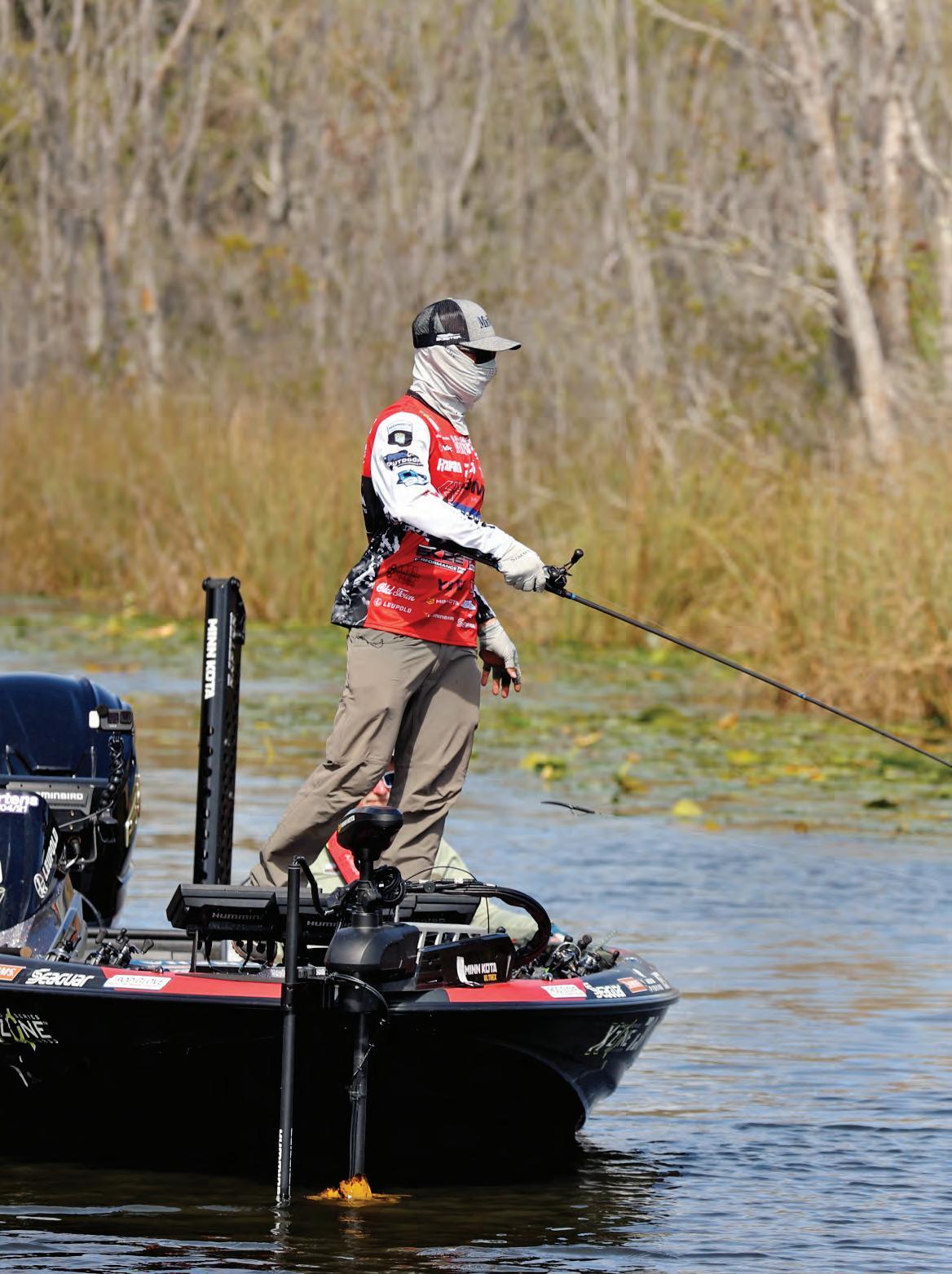

The Bassmaster Elite Series opens its 2023 season Feb. 16-19 with a stop at Lake Okeechobee. It’s the first time since 2017 that B.A.S.S.’s top pros have competed at the “Big O,” and depending on the weather, most pundits are predicting heavy sacks from some of the world’s best bass anglers.
Last time Elite Series anglers descended on Florida’s largest lake in 2017, they also fished in late February. A monster 9-pounder turned heads as the big fish of the tournament. Alabama pro Tim Horton topped the field with a fourday total of 83 pounds, 5 ounces. That’s a better-than 20-pounds-per-day average, which is strong for any fishery, but it’s not
as good as it gets for this historic big-bass factory.
Back in December, locals Jerod Boltz and Jon Bowman secured the 2022 Roland Martin Marine Center Series Championship with an awesome, nearly 30-pound final day on Dec. 11. Their big fish of the day was an 8.15-pound Okeechobee giant. They caught most of their fish on chatterbaits, an Okeechobee favorite, and spent some time fishing speed worms and flipping cattails.
With two months separating the Roland Martin event from the Elite Series event, there’s no doubt some things will change, but Florida’s mild winters mean some things will likely remain the same.
By CAM StaffOkeechobee is typically primed for big fish in the month of February, and there might be some bed fishing going on. “Big O” bass will likely be up shallow in all stages of the spawn.


As with any fishery, weather patterns have a way of ruining the best laid plans. February fronts from the north are notorious for shutting down hot Florida bass bites in a hurry. Last February, Coastal Angler contributor Capt. Angie Douthit reported consistent action with spinnerbaits, worms and chatterbaits, and said they were also catching fish flipping and pitching.
For more deatils, visit www.bassmaster.com.

Regardless of the species, extreme water temperatures—hot or cold—are stressors that can reduce the chance of survival when catch-and-release fishing. With February bringing some of the coldest fronts of the year across the continent, here is some science gleaned from the non-profit Keep Fish Wet to help you best handle fish you plan to release.
In a blog post, Sascha Clark Danylchuk gave some tips and observations. Here they are along with some of our thoughts on how this affects anglers.
Falling Temps - Fish are cold-blooded. As water temperatures decrease to the lower end of their comfort range, so do fishes’ metabolisms. Their ability to swim, feed, digest and avoid predators all decrease. Fish are more sluggish and feed less when water temps reach the lower end of their tolerance rage.
Whether its seatrout on the coast, bass in a reservoir or trout in a river, cold fish seek out
warm-water refuge and sometimes aggregate where the temperature is more comfortable. This could be deeper pockets in a river, stream or coastal bay, or it could be up sun-warmed creeks and canals on the coast.

Even when they’re cold, catching can be easy when fish are piled up. Take care to release them back to the thermal refuge where you found them.
Reduced Forage - Fish feed up ahead of winter to pack on fat that will carry them through to spring. With reduced ability to feed and fewer foraging opportunities, these fat reserves are energy that depletes as winter progresses.
Energy expended during the fight or to heal a hook wound or replace slime coating can affect a fish’s ability to survive. Consider gearing up to reduce fight time and using barbless hooks during winter to give released fish the best chance of survival.
Pay Attention to the Fish - Energydepleted fish combined with less forage creates a

situation in which fish must feed opportunistically to survive. Pay attention to the fish you catch. If they look skinny or unhealthy, go fish somewhere else.
Lessons from Ice Fishing - Even if you’re not ice fishing, ice fishing studies reveal some other factors worth considering when fishing at the lower end of the temperature tolerance range for a given species. Stress responses decrease in intensity with lower water temperatures, which is good for catch-and-release situations; however, those stress responses can also be prolonged or delayed. Just because your fish swam away, doesn’t mean it’s OK.
One last item to consider is air exposure, and this is more relevant when it’s very cold outside. “If the guides on your rod are freezing up, consider how delicate gill tissue might respond to air exposure,” wrote Danylchuk.
To read the entire blog post, visit www.keepfishwet.org.


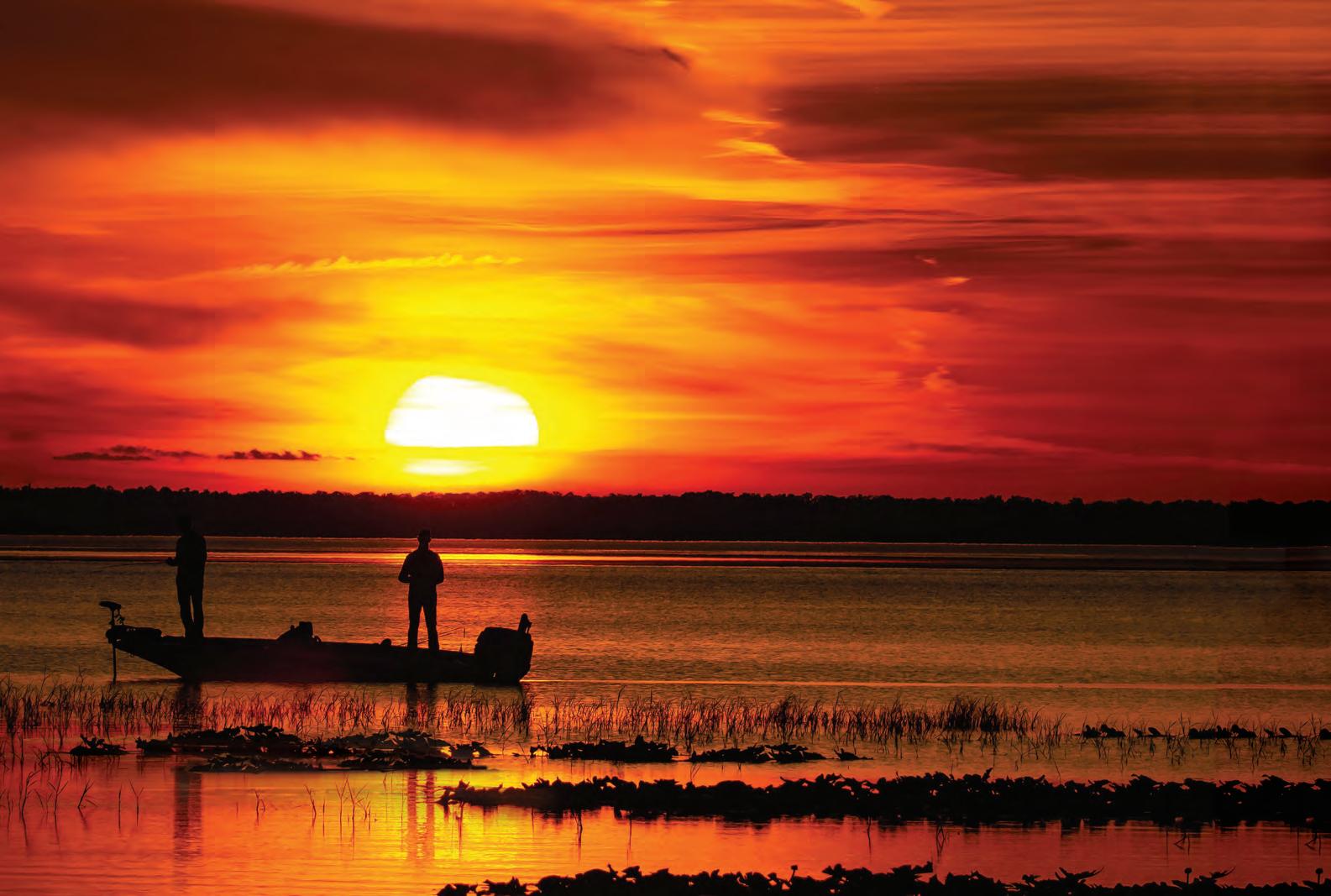

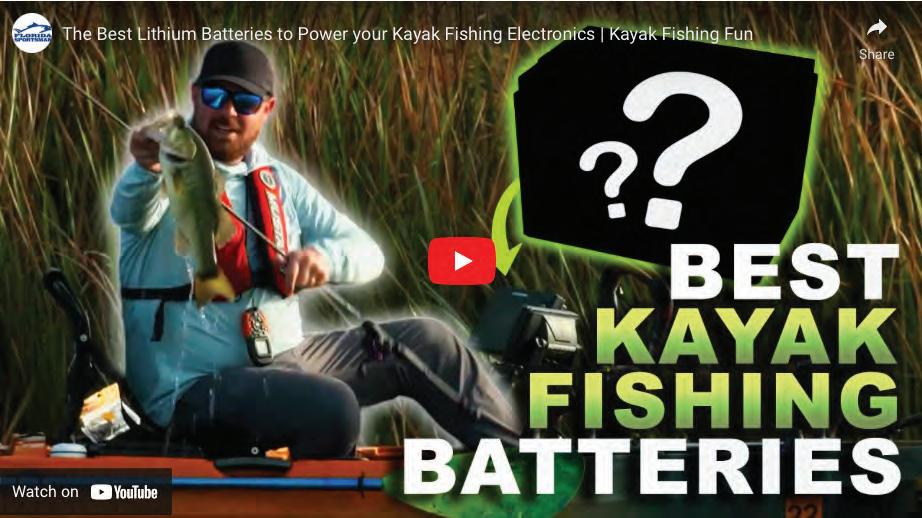
The master lurecrafters at LIVETARGET have perfected the frog lure to create the first-ever surface bait that looks and swims just like a real frog. The LIVETARGET ULTIMATE FROG is unmatched for realism in form and function and triggers violent topwater strikes from the largest and wariest freshwater predators.



The key to sparking uninhibited aggression from the oldest and smartest bass, pike, walleye and musky is perfect mimicry of a real frog. Through extensive research and development, LIVETARGET produces lures with species-specific profiles, anatomical details and color patterns as well as ultra-realistic motions and actions.
At rest, the ULTIMATE FROG hangs at a 45-degree angle with eyes bulging above the surface, just like a real frog. With a gentle twitch, the legs kick—hinging at the hips and knees—to thrust the body forward and down with a swim-like stride before they retract to reset for the next forward stroke.

From below, predators see an exact replica of a live frog in both looks and behavior. There’s no hesitation or further inspection required when an intricate sequence of biometric motions convinces gamefish they are hunting down the real thing. This truly is the ULTIMATE FROG.
The LIVETARGET ULTIMATE FROG is constructed of the most scientifically advanced materials to provide lifelike action as well as incredible durability. They are available in two models, two sizes and eight colors to match your fishing preferences and habitats. The Popper model pops and then drums with a one-knock rattle to draw attention. The Finesse model swims silently and stealthily to convince wary or pressured fish that it’s time to eat.
A lure for big fish such as Largemouth Bass and Northern Pike. Slim profile. Especially effective over submerged grass and timber. Internal tungsten ball. Soft knock sound. Easy to walk.
The ULTIMATE FROG is available at LIVETARGET dealers in 2023 with an MSRP of $17.99.
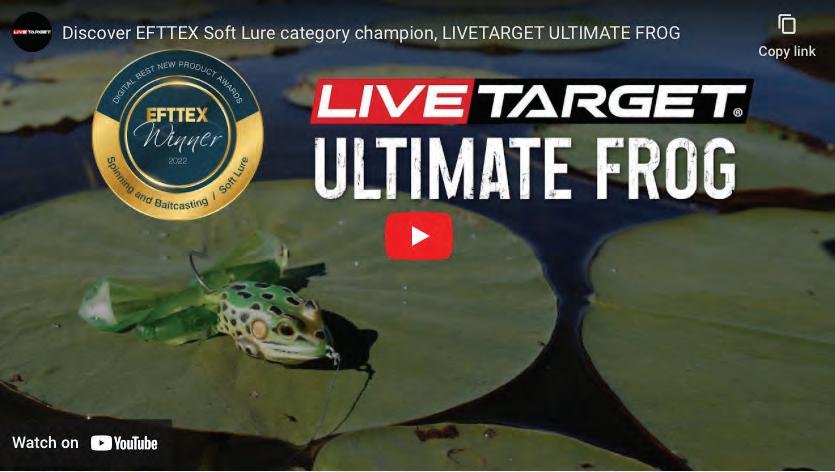

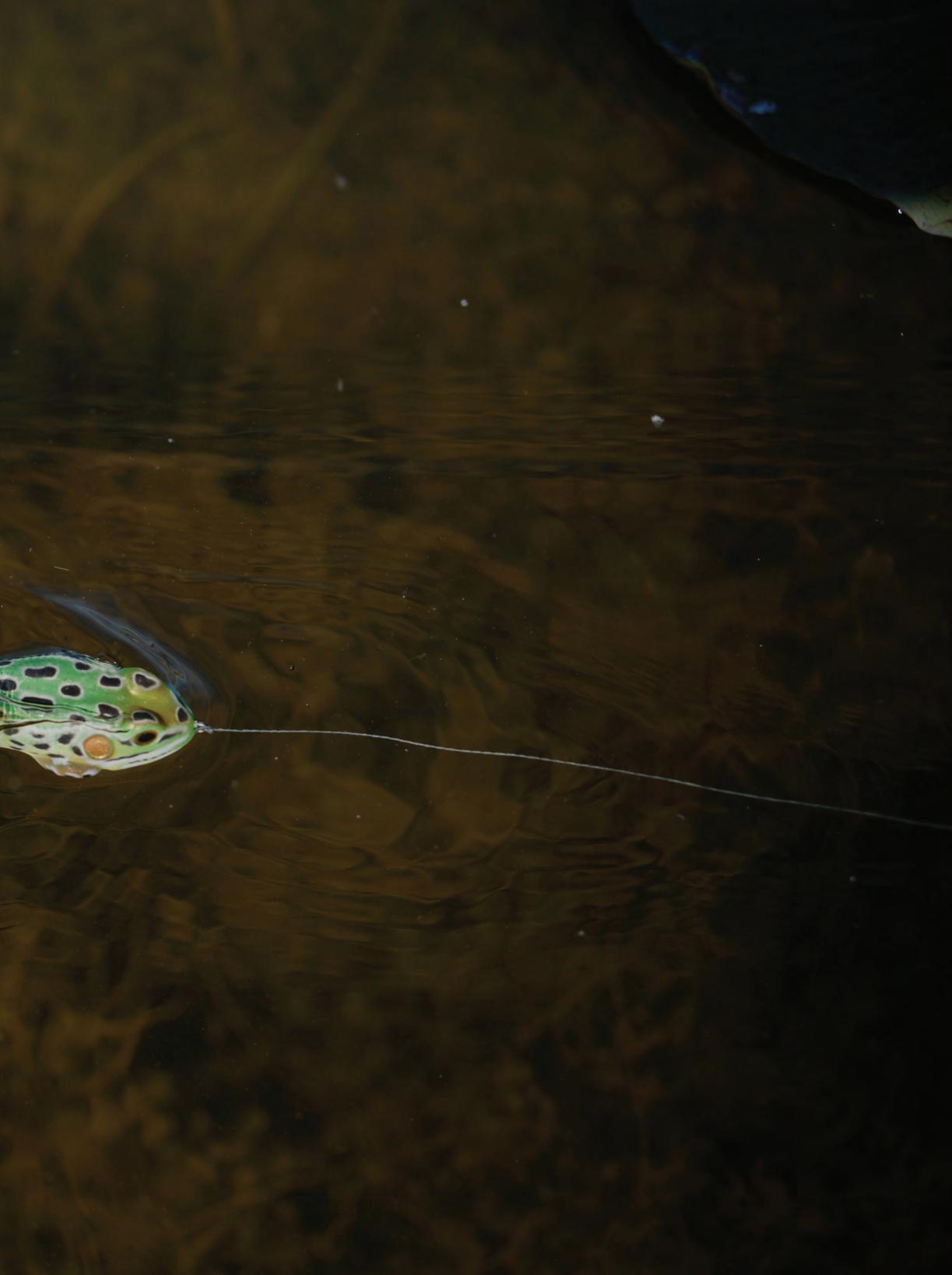
LIVETARGETLURES.COM

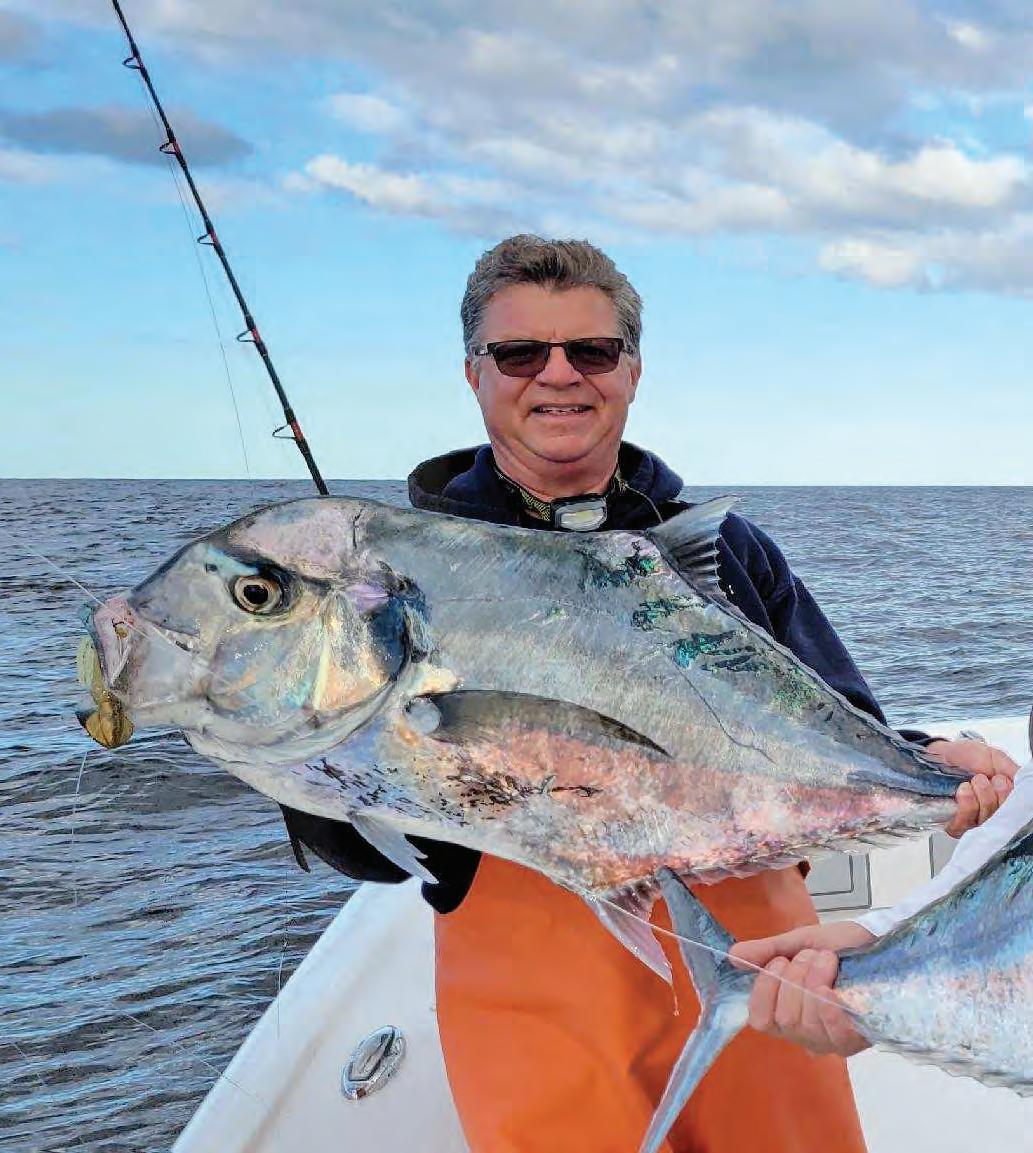 By Nick Carter
By Nick Carter
For most anglers, African pompano show up as welcome bycatch on bottom-fishing trips for other species. But with the restrictive seasons on standard structure-oriented offshore targets like grouper, snapper and amberjack, African pompano have become a primary target. In terms of gameness and quality as table fare, some might argue they belonged near the top of the list the whole time.
“They shut down grouper fishing in January, and I’m not going to stop going offshore, so they’re the next likely candidate,” said Coastal Angler’s own Capt. Tim Barefoot. “They pull hard, they bite and they taste great. I’d put them up in the top five of my favorite fish to eat.”
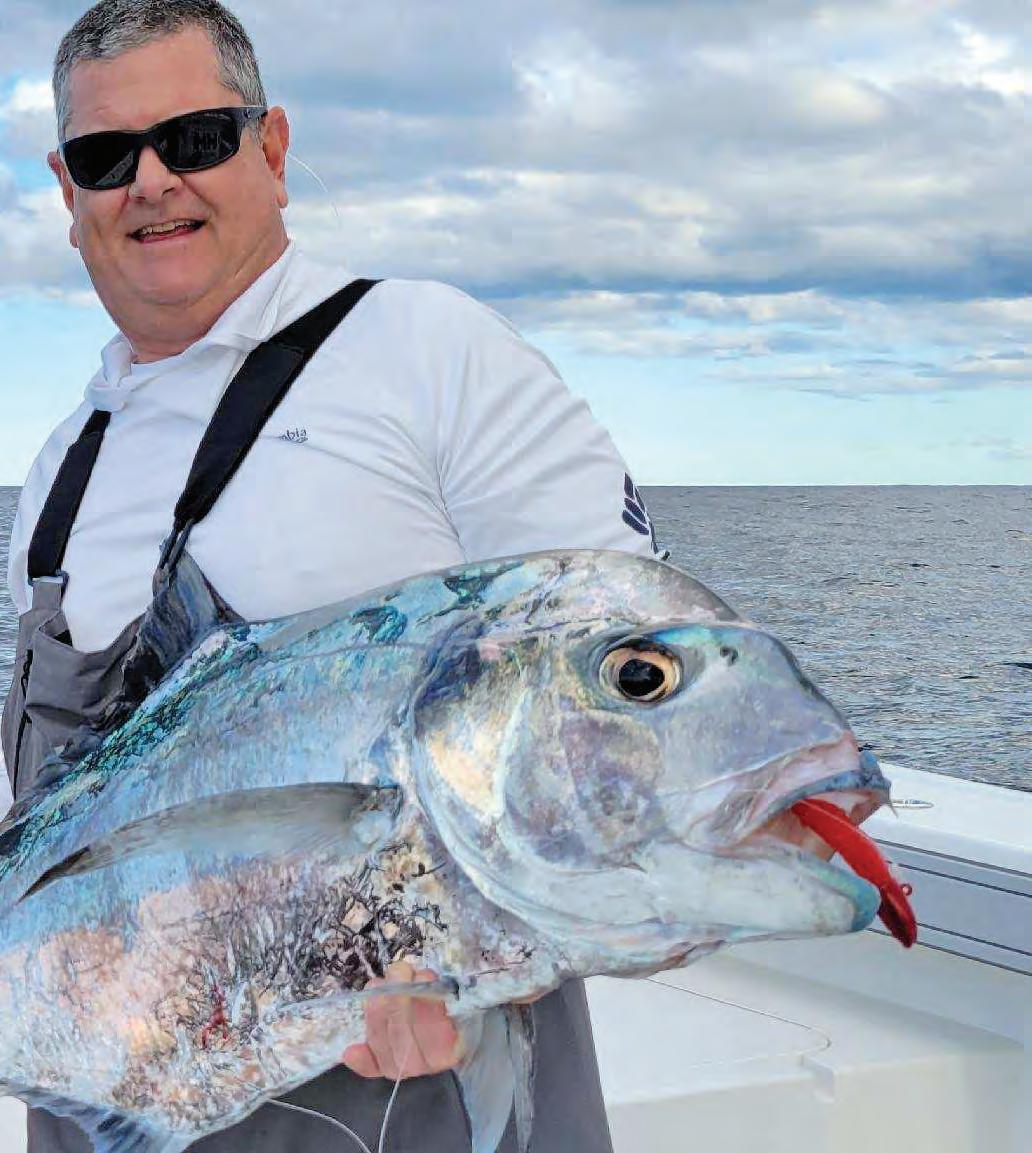
African pompano school up on nearshore and offshore structure in late winter and early spring on the Atlantic and Gulf coasts. A couple of years ago, Barefoot was introduced to a ridiculously good bite for scads of 15- to 35-pounders out of Wrightsville Beach, N.C., and what he learned might help you dial in the bite where you fish.
African pompano are a tropical species of jack and prefer 65- to 80-degree water temperatures. Cold water consolidates them to their comfort zone this
time of year, and out of Wrightsville Beach anglers find the magic 65- to 67-degree temps 45 to 60 miles out on 120- to 200-foot-deep structure. Capt. Rick Croson, of Living Water Guide Service, showed Barefoot this bite for the first time, and on that trip, they caught African pompano until they were tired of reeling them in as well as a few amberjack, a dolphin and several blackfin tuna.
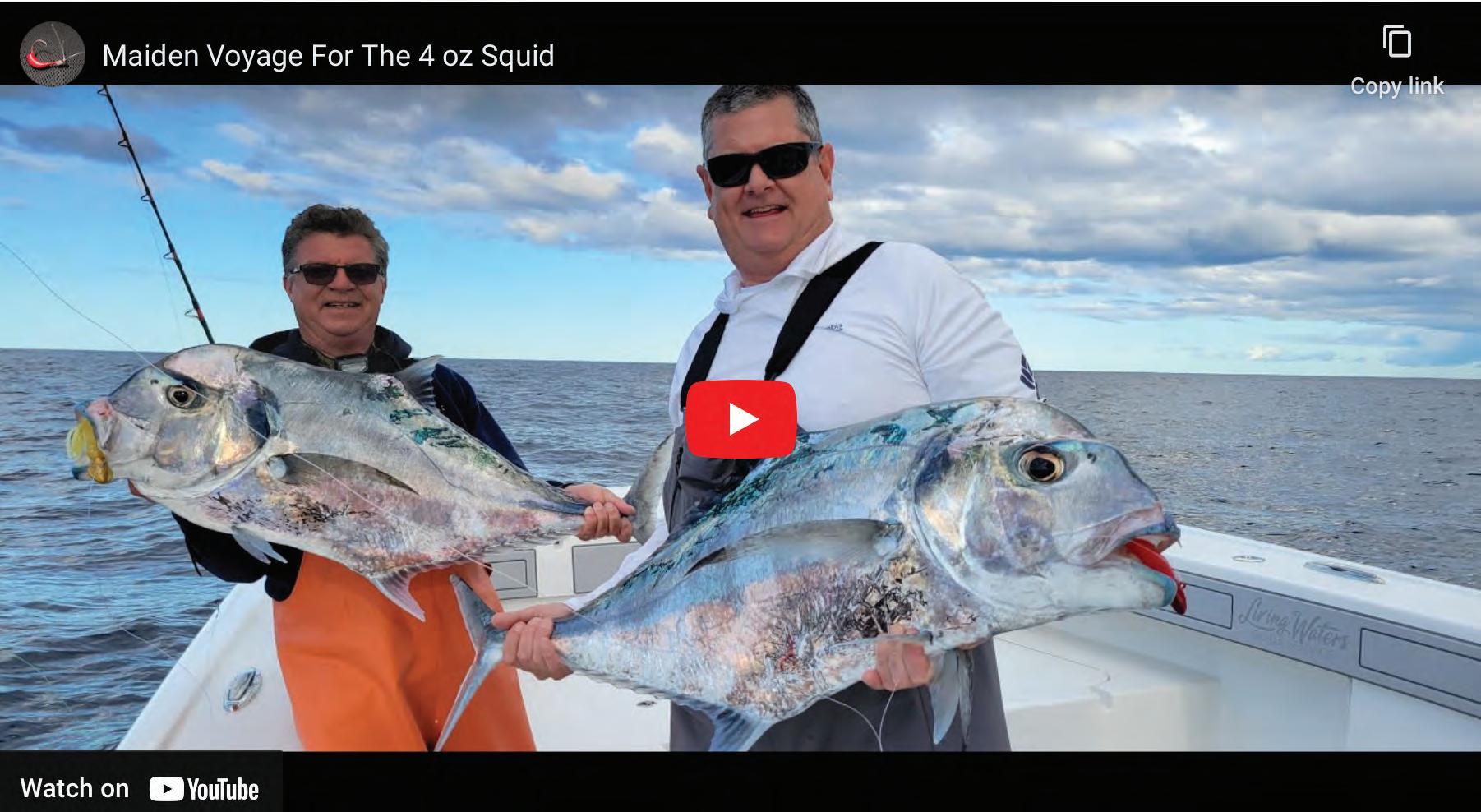
With African pompano, the widely accepted best way to catch them is with a flutter-style jig. They are suckers for flashy moving objects. However, if you know Barefoot, you know he is not content with a tool or technique until he has tried to find a better way to do it. He’s an obsessive tinkerer, and that makes him a better angler.

“They are extremely susceptible to flutter jigs, but the problem with those is the teaser assist hooks. We kept hooking them on the outside of the face with those wired stinger hooks,” he said. “With their thin, delicate skin and hard bone underneath, it’s tough to get a hook set. We were losing a lot of fish.”
The technique Barefoot settled on is to use his own 4-ounce Squid Decoy Jigs.
“African pompano are very close to the bottom,” he said. “We drop that squid down to the bottom and pull it up just a few feet. Sometimes you can just set it in the rod holder and wait for it to get slammed. Sometimes you might want hold it and give some action, but don’t overdo it. Squid are their primary food source. When they see it, they’re not shopping… they’re buying.”
Barefoot uses 40-pound braid to an 80-pound fluorocarbon leader. He ties on his jig with a loop knot. The thing about squid is fish always hit them from behind in order to disable the sharp beak in the middle of their tentacles. Barefoot said African pompano, as well as grouper and many other species, almost always take the squid jig deep, and the result is a solid hook set in the mouth.
Putting a squid in front of a school of African pompano is a surefire recipe for some fast action. One last thing: gaff them in the belly because their hard heads are nearly impossible to gaff.
Find Capt. Rick Croson at livingwatersoutdoor.com. Check out the Squid Decoy Jig at barefootcatsandtackle.com.
Micron Navigator is a unique and revolutionary antifouling that combines both water-based and copper-free technologies enabling optimum fouling control for all waters and boats. This technology delivers multi-seasonal protection via a lower concentration of active ingredients, achieving a more environmentally responsible antifouling without compromising premium protection as you explore your world.
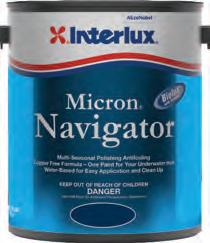
Interlux.com
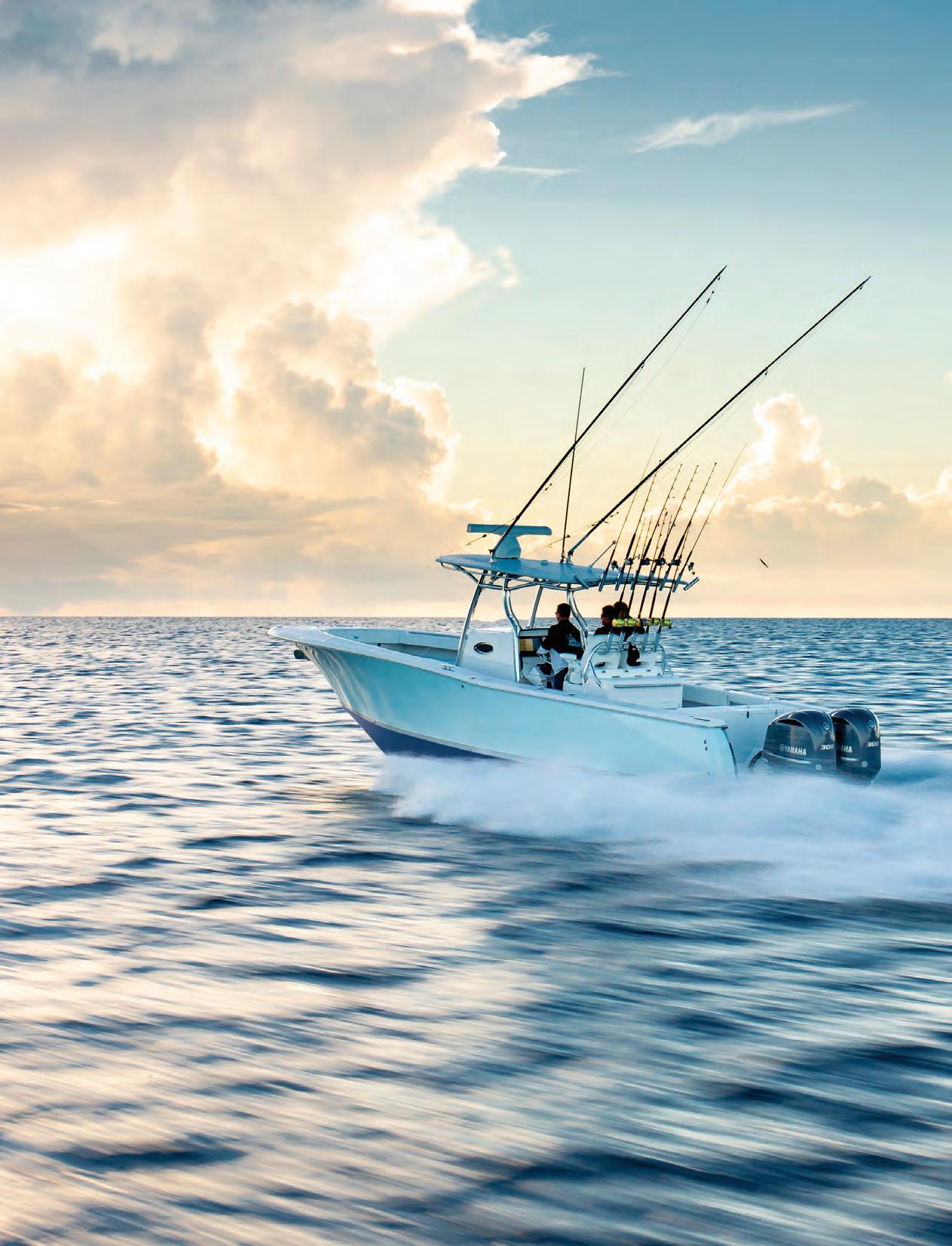




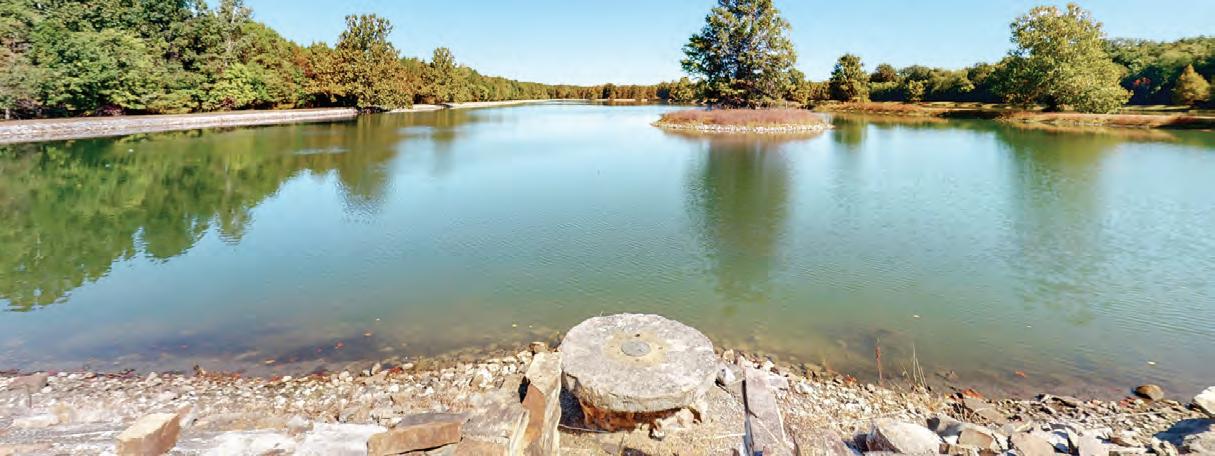
300 SCILLION DR. • CALVERT CITY, KY 42039


One of a kind 4 Bedroom log home with a privately owned 20 acre lake. Includes guest house and large metal storage building. The home sits 20 feet from the beautiful lake! Custom built and all original!
GUEST HOUSE

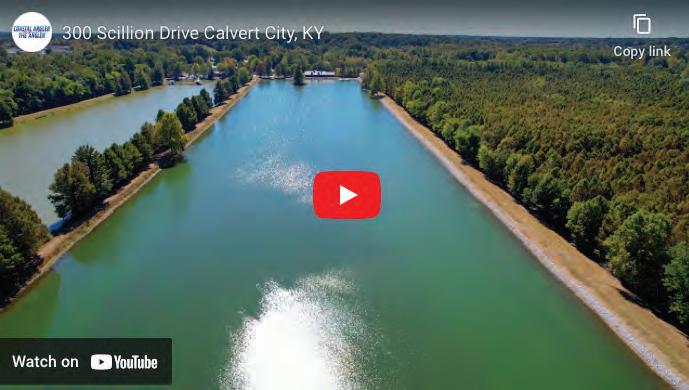
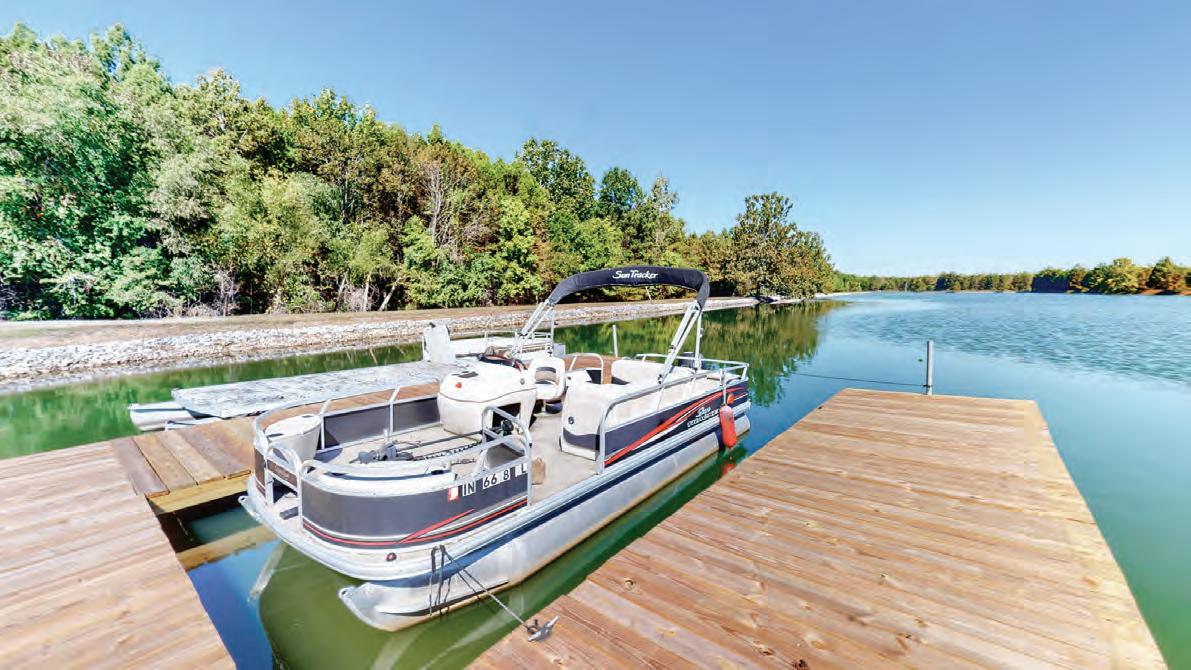




Dometic has redefined the ease of use and practicality of a basic trim tab system. Featuring an intuitive dial controller, you can easily adjust the pitch and roll to get your boat on plane quickly and efficiently. A programmable favorites button makes for effortless operation. While its innovative, rugged design and autoretract feature, ensure reliability and safety on the water, whatever the conditions.

Trim tabs help level a boat in any situation, resulting in better control of the vessel for the skipper and a more comfortable ride for everyone onboard. In addition, a quality trim tab system will enhance overall boat performance and increase fuel efficiency by adjusting the vessel to its optimum running angle in various sea and weather conditions.
Trim tabs help get boats out of the hole and onto plane faster. They can also be adjusted to stop a boat from “porpoising” — the cyclic and rhythmic oscillation of the powerboat in relation to pitch and heave. Trim tabs also help keep a vessel on plane at various speeds, for a more comfortable and efficient ride. Lastly, trim tabs can help reduce listing, the roll or tilt of the vessel due to propeller torque or uneven weight distribution.
Any planing hull powerboat will benefit from the addition of trim tabs. A quality trim tab system can transform your boating experience and provide easy, confident control in a variety of conditions.
First, a vessel that gets on plane more quickly spends less time running at inefficient ride angles. Trim tabs can also allow a vessel to remain on plane at lower engine RPM. The
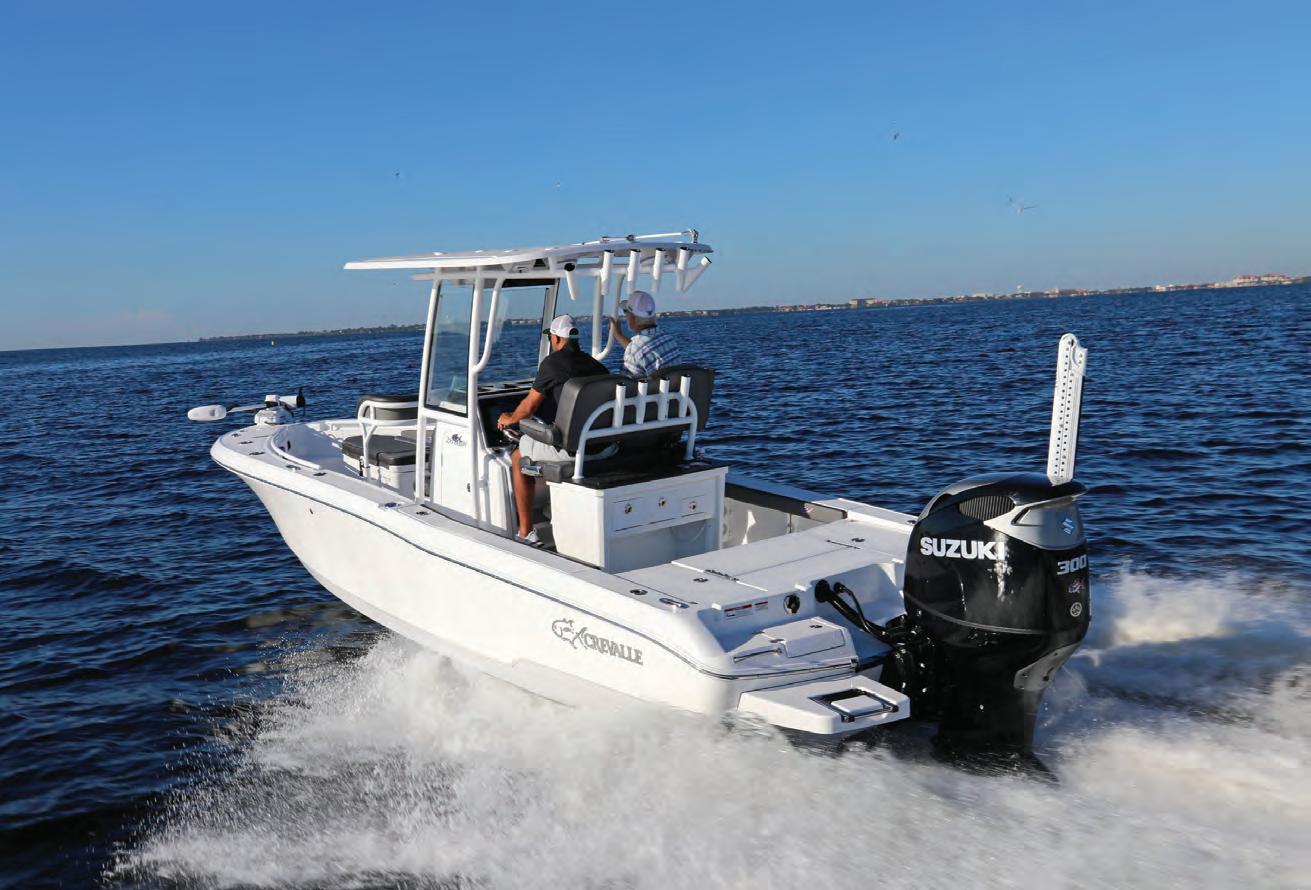

The intuitive dial controller makes both the Dometic Standard and Dometic Adaptive trim tab systems unique. The dial allows for easy and precise adjustment, removing any guesswork from leveling your boat. The controller allows you to easily adjust pitch and roll to get your boat on plane quickly and efficiently. The controller works by simply turning the dial in the direction you want to level the boat. The actuators respond quickly and precisely to adjust the ride. There are also single press Bow Up and Bow Down buttons for manual adjustment, and a Favorite Button
ability to “fine-tune” a boat’s running attitude and balance in the face of wind, waves and other conditions helps reduce hull drag and fuel consumption in various conditions.
to return to boat’s “sweet spot” ride position with the touch of a finger. The system’s Home Button quickly moves the tabs to home position. WWW.DOMETIC.COM

Back on August 26, Matthew Marovich had a record-breaking day out of Sarasota, Fla. He was slow-pitch jigging in deep water when he landed two fish that the Florida Fish and Wildlife Conservation Commission recently announced as state records.

Marovich caught a 5.56-pound red porgy that bested a 2019 record of 4.8 pounds. He also boated a big 10.55-pound blueline tilefish that smashed the 2021 record of 5.4 pounds.

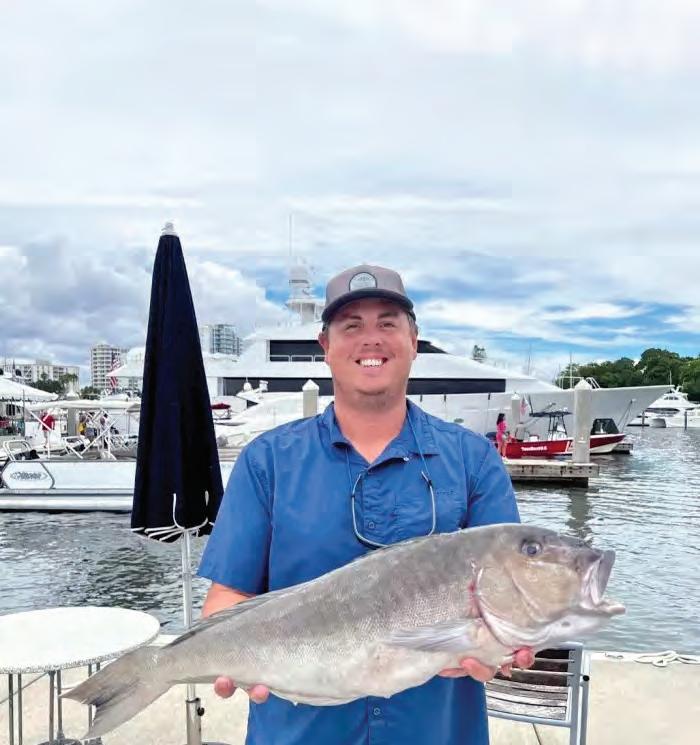
“Both fish were unexpected catches. I thought I had a queen snapper when I pulled up the biggest red porgy I had ever seen!” said Marovich. “The blueline tilefish felt like a grouper. We were grouper fishing and I was using the slow pitch jig and thought maybe a good sized scamp grouper or a yellowedge was on the other end. I also knew there were snowy grouper in that area. Tilefish is one of my favorites to eat, so it was really exciting to see such a nice blueline come to the surface.”
The IGFA all-tackle world record for blue line tilefish was caught off New Jersey in 2015. It weighed 23 pounds, 4 ounces. The all-tackle world record for red porgy was caught out of Gibraltar in 1997. It weighed 17 pounds.
For to see current records, visit CatchaFloridaMemory.com.




Lasting 2-3 times longer than wooden, concrete, and aluminum docks, our modular floating system is the preferred dock choice for residential, commercial, marina, liesure, and other applications. Customizable and configurable for boat docks, liesure and recreation docks, and drive-on jet ski and personal watercraft!


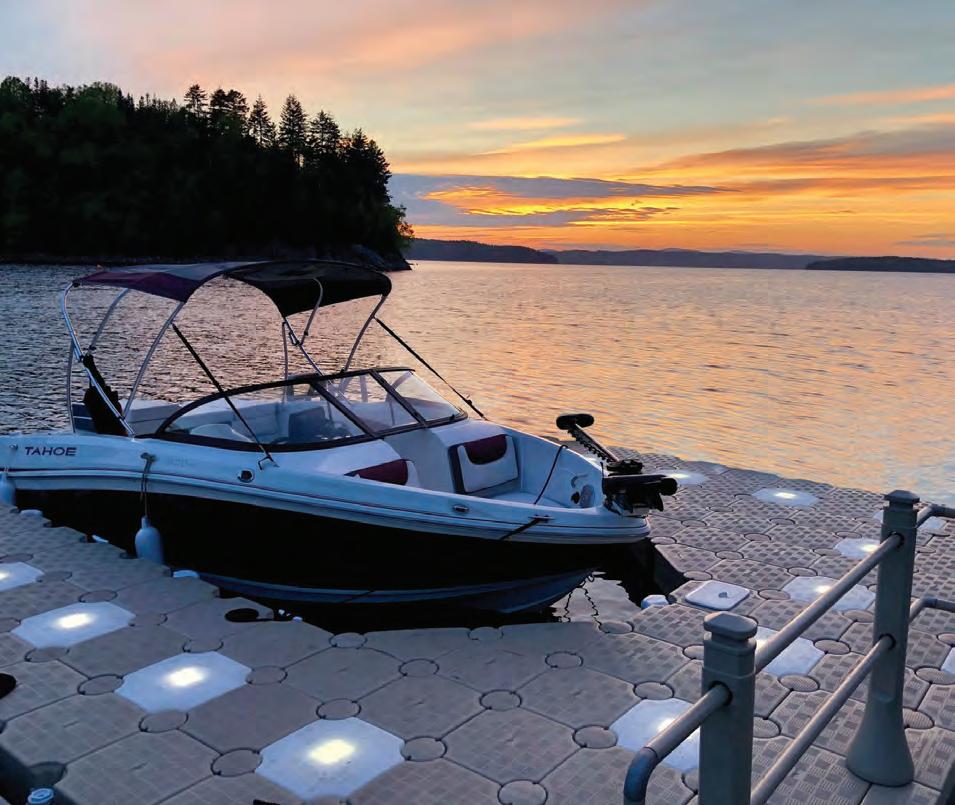

• High-quality plastic
• Environmentally-friendly
• Guaranteed for 20 years
• Near-zero maintenance
• Completely customizable
• UV and pollution resistant
www.candockcfl.com







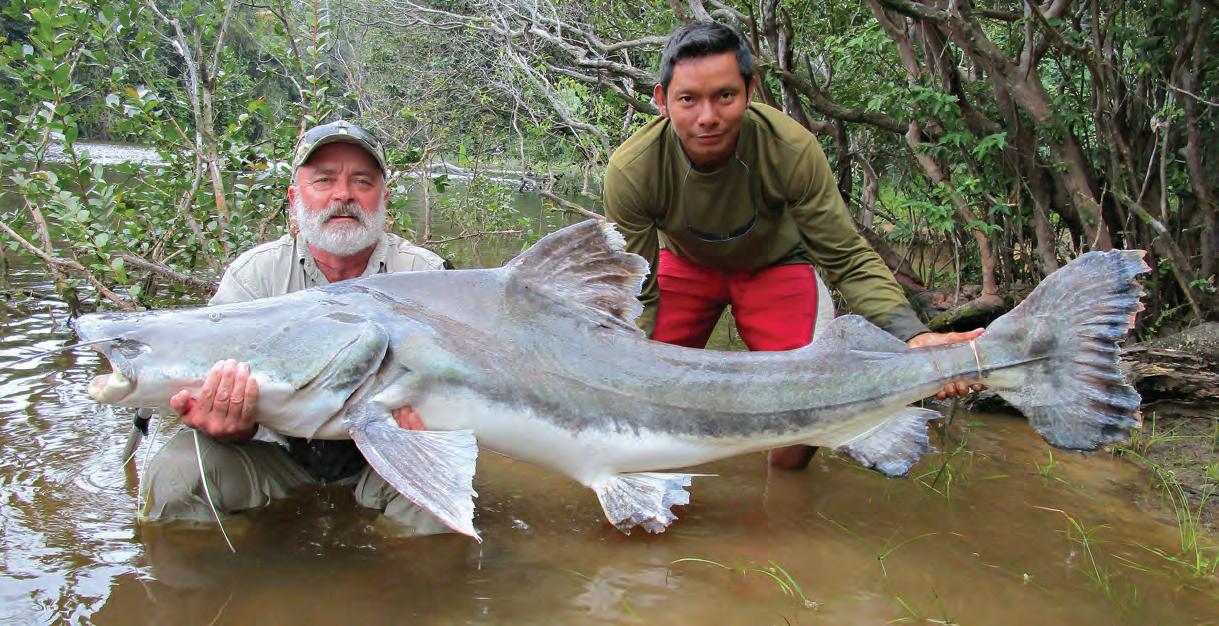 By Riley Love
By Riley Love
’ll never tire of watching this, the instant when a new traveler realizes how different this place is from what they expected. Suspicion that this place would be threatening, and the defenses that were raised simply dissolve. It is one of the most tranquil, inviting places you will ever be. Inner peace, unanticipated and profound, slows the heartbeat, relaxes the brow. It’s so very good to be here in the Brazilian rainforest.
Gliding by, your eyes realize the system of the rainforest. Kapok trees, growing to 200 feet and a thousand years old, form a canopy that absorbs up to 80 percent of the sunlight. This is Guyana Shield country in northeast South America, encompassing about 40 percent of the biome between the Orinoco and Amazon rivers. The Amazon basin, greater than the next seven largest rivers combined, contains 20 percent of all earth’s fresh water. It is
the most biodiverse place on our planet. The Amazon, with its 15,000 tributaries, supports by far the largest number of fish species of any system: 3,507 and they’re still counting new discoveries. It is a wonderland of fishes.
A good experiment for a quiet moment— sink a few breadcrumbs beneath the surface in any of these rivers. The myriad iridescent colors, geometric shapes and exotic fins that swim into view staggers the imagination.
When sixteenth century Spanish explorer Francisco de Orellana was attacked here by native warriors led by a woman, it reminded him of the Amazons of Greek mythology. Although some scholars feel the name derives from the native word amassona, meaning “boat destroyer.”
Acute Angling, outfitter of multiple Amazon trips, calls this expedition Rio Travassão, meaning “river crossing” in Portuguese. It is their multi-species trip. Extensive stretches of



whitewater rapids guard this plateau segment of river. Twenty miles downstream live 11 families of Hixkaryiana (red deer people) Amerindians. A large wooden supply boat provisions the village regularly. No floating bungalows or motherships can come where the Cessna Caravan float plane landed at the hand-hewn “Picapau” lodge and the satellite camp upstream. Only small, shallow-draft, well-powered craft can negotiate the torrents.
There is no replacing the efficiency of flying right into camp, or the stocking. The pilots unloaded tanks of fuel, a large deep freeze, huge tents, four new outboard motors, rods, reels and… live chickens.
Tuncunaré, or peacock bass, are the predominant sportfish of the realm. There were five reported species on my first trip 35 years ago. Today it’s up to 16. These are cichlids, of which 1,700 species are found about the world. Our unrelated North American bass are in the

sunfish family. Cichla ocellaris is the species introduced into the fishery in South Florida. It is too cold sensitive to survive anywhere else in The U.S.
Authority extraordinaire Paul Reiss has a well-organized directory on the Acute Angling website. Cichla vazzoleri was the species predominant in these waters. They grow up to 15 pounds. During our trip, we boated many 12s or better; my average peacock was 8 pounds.

There are areas in Brazil with clear water, but the hallmark of this environment is black tea-colored flow, tannin stained from the leafy vegetation—just like a cup of tea. It is how the Rio Negro got its name. The ionic concentration is much lower than white water but so is the pH or acidity. The net result is an unfavorable environment for breeding of the larvae of mosquitoes and other biting insects. I didn’t even bother to bring repellent and never had a bite.
They have five species of catfish here and organize a grand slam. Some grow to triple digit weights, equaling my heft after the Thanksgiving weekend. Acute Angling claims a couple of world records here, including the bicuda and the black piranha at 8.5 pounds. Payara, the “vampire fish” is good game and grow large here, and so do trairão or “wolf
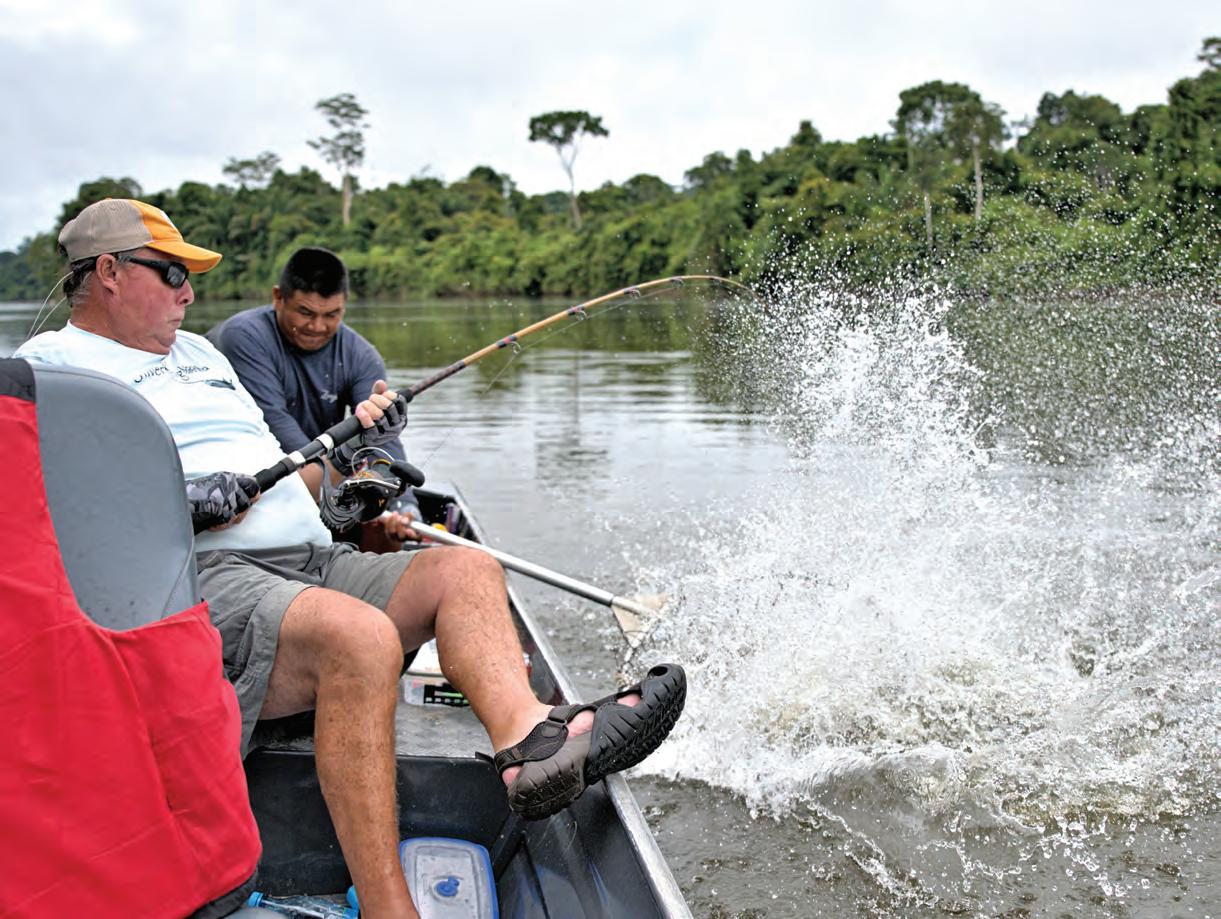
Payara are punk rockers with a need for fastmoving water. And peacock bass? Nice ones are first round NFL draft picks.
When my last breath just exhales and everything is going dark inside, my final thought will be… what do they want?
Topwater plugs are part of the addiction of this fishing. Big poppers and prop baits rip the surface enough to scare off American bass. Magnum minnows and exotic Amazon jigs on multiple rods are ready for your hand before sunrise. Soft baits tend to return to the boat without a tail after the first cast.
Addiction boosters are the exotic beauty and extraordinary strength of these fish, only comparable to saltwater species. Extra heavy line and hardware are barely enough. It’s paradise for the fly fisherman. The best of these readily take topwater poppers and large colorful streamers.
The season of low water levels is crucial. The water elevates in the wet season far into the forest where no fly or lure can go. Shrunken down to its skeleton, the river presents many targets in lagoons and behind pachyderm boulders.
A dividend is the wildlife along the river, unpressured by human presence. An adult jaguar, black and gold fur reflecting the sun’s rays is breathtaking. Monkeys, caiman even
proportion to their relationship. My favorites are the yellow-rumped cacique, which create teardrop shaped hanging nests.
We were on reservation lands for indigenous people. Permission was negotiated with the tribe and payments made to maintain the fishing enterprise. We asked for some fish to be kept for dinner. Permission was needed from tribal representatives, our guides—Joao (Xowanu Waraka) and Artema (Artemas Wahtxo)—next in lineage to become chief. Although there is evidence of hominid migration into the Americas much earlier, the aboriginals hereabouts were felt to migrate across the Siberian land bridge from Mongolia and Siberian Asia 17,000 years ago. DNA evidence demonstrates shared genes not possessed by humans on any other continent. Common segments of their spoken language coexist in Mongolia today.
Locals concur many uncontacted native tribes wait to be discovered. Heavy precautions exist for this eventuality. Before European
3 million indigents spread across the Amazon basin. Ninety percent died in the first 100 years from exposure to European diseases. About 900,000 are estimated today. In the past, whole tribes fell ill with pneumonia after first contact.
The camp’s nucleus is the kitchen, with open walls and thatched roof. The cook appeared wearing a “Never Trust a Skinny Chef” T-shirt… and the culinary symphony began. Multiple course dinners were served with wine and freshly baked breakfast breads. A deck extended into the rapids with an Arthur-worthy hardwood table for late-night conversation.
There are strong forces at play here, the mystical pull of dark water and forest. Our host, Wellington told me a story about bringing his children here. His daughter asked what this place would have looked like 500 years ago. He closed her eyes and when she opened them, she understood that not much had changed.
Manaus Brazil is previously the largest city in the world unconnected to any other by road (now there is a road) and the richest city in South America during the nineteenth-century rubber boom. Here the dark waters of the Rio Negro join the pale flow of the Solimões to form the Amazon, dwarfing all other rivers. It is 2 to 6 miles wide and 328 feet deep. Marvelous to explore, Manaus is heart of the journey for international anglers, a world class piscary in every sense.
Acute Angling, progeny of Paul Reiss, a tropical ichthyologist, and his brother, Gary maintains four distinctly themed trips to the region and an additional exploratory trip. This was the most well-organized turn-key expedition I’d ever seen. From obtaining initial documents, flight booking and Covid testing—it was a well-oiled machine. At camp, every item was ready and waiting, even lures with switched out strong hooks. All you really needed was three changes of clothes in a backpack on your shoulder as you stepped off the plane. I did bring my own fly rod, as all their tackle is conventional. It is rainforest, and even during dry season, it rains unpredictably.
Even now, water flows down the eastern slopes of the Andes giving birth to the headwaters of the Amazon. Wondrous fish, never seen by man, glide along their secret places. Under the yellow moon spirits haunt the forest’s shadows. The eyes of jaguars burn bright from the river’s edge. It’s waiting for you.
For more information, visit www.acuteangling.com






Shown with optional solar charging system
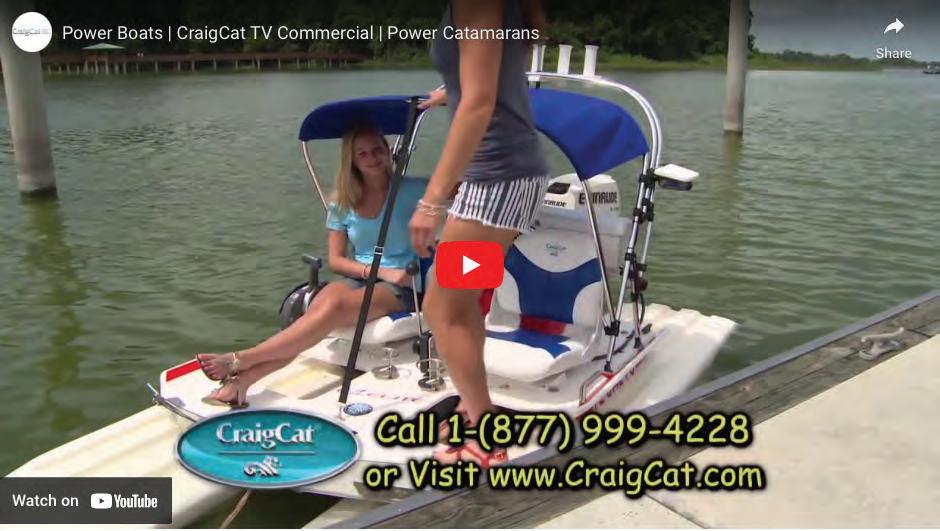
$7,469 + tax and registration

 By Will Schmidt
By Will Schmidt



If you don’t already troll for grouper or if you’re looking for ways to improve your success rate, here are some things to consider while we wait for the seasons for our most popular species to reopen.
Large-lipped and big-profile plugs are deadly, but many anglers struggle with getting lures into the strike zone. Many think if they are fishing in 30 feet of water they need a plug that dives 30 feet, but that’s not always the case. Maximum dive depths are with everything optimum: speed, amount of line out and rigging.

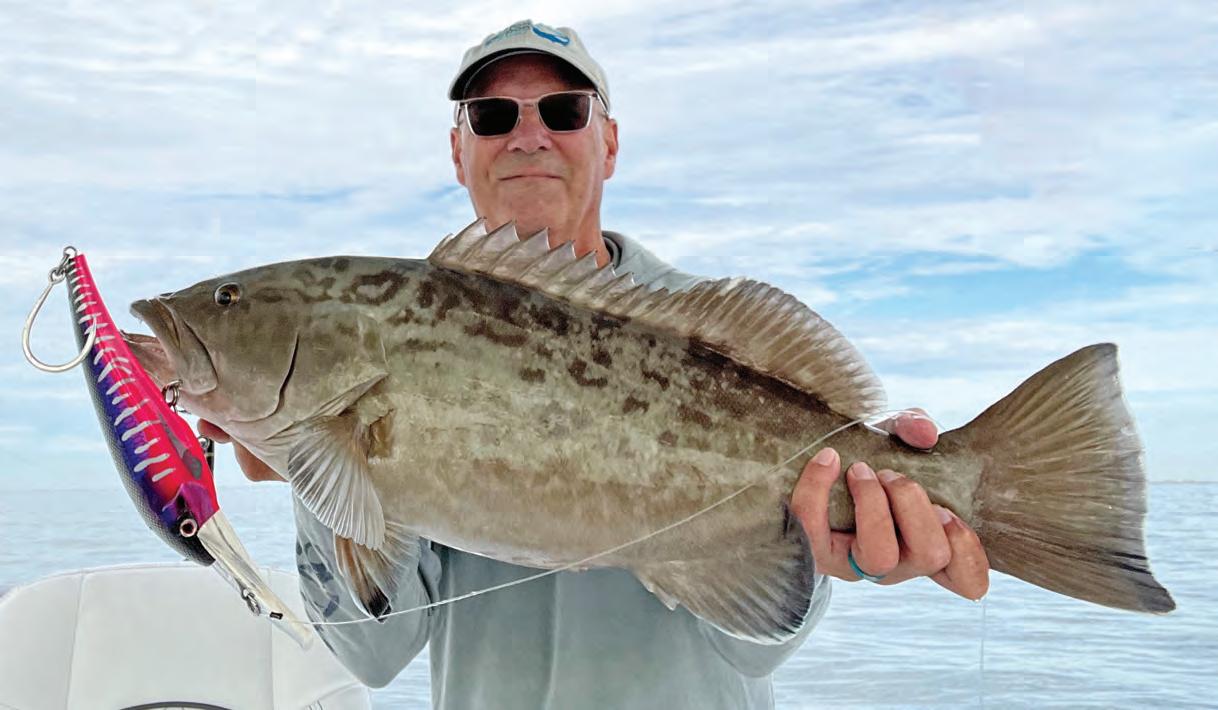
First, consider your speed. I use Nomad DTX Minnow lures which are designed to run anywhere from 20 to 50 feet at speeds of 2 to 12 knots. The plugs will dive deeper at the higher end of that speed range than the lower end. I usually run about 5 knots and can easily get a 40-foot plug down to 30 feet at that speed, but a 30foot plug would likely be
short of the bottom.
The amount of line you have out also greatly affects the depth your plug is running, and this is where many mistakes are made. Slower speeds equal a flatter angle of descent, so more line is needed. The idea is to be so close to the bottom that you occasionally bounce off it. Watch your rod tip for signs of the lure bouncing off the bottom. You will likely find you need more line than you think. Keep dropping back until you start hitting bottom. The downside of this is you will get snagged on the bottom occasionally. When you do, don’t just try to wrench it off the bottom, get back behind the lure and pull it off in the opposite direction. A plus to the DTX Minnow is the single hooks seem to come off the bottom easier than treble hooks.
The final piece to the puzzle is your rigging. Pulling 8- to 9-inch lures, and handling the fish that smack them, means you need stout tackle. But heavier lines create drag in the water that will impede the lure’s ability to dive. Using braid is a huge plus, as the diameter is much smaller and creates less drag. To further streamline, I use crimps on my leader between my lure and a small (but strong) swivel. It’s a little thing, but knots on heavy leader can be bulky and add to the rig’s drag.
Heavy drags as well as keeping the boat in gear helps pull the fish away from cover quickly. Large single hooks aid in keeping you connected as the bigger gaps decrease the possibility of ripping the plugs out of the fish. Trolling is fun way to catch grouper and it’s a great way to find new spots, as you can cover a lot of ground.
Will Schmidt is a seasoned tournament angler who has been writing about fishing for more than three decades. Check out Nomad Lures at nomadtackle.com.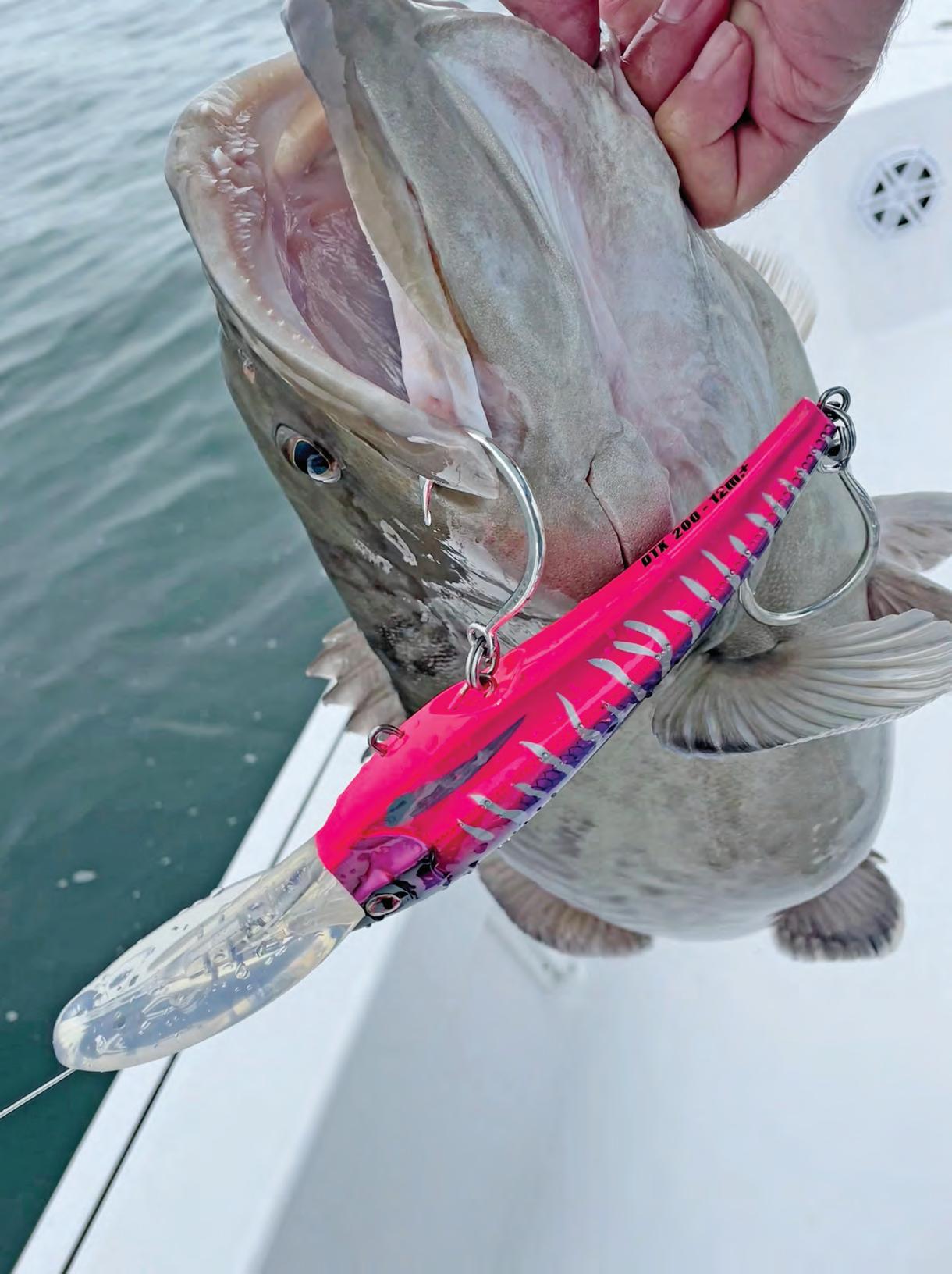
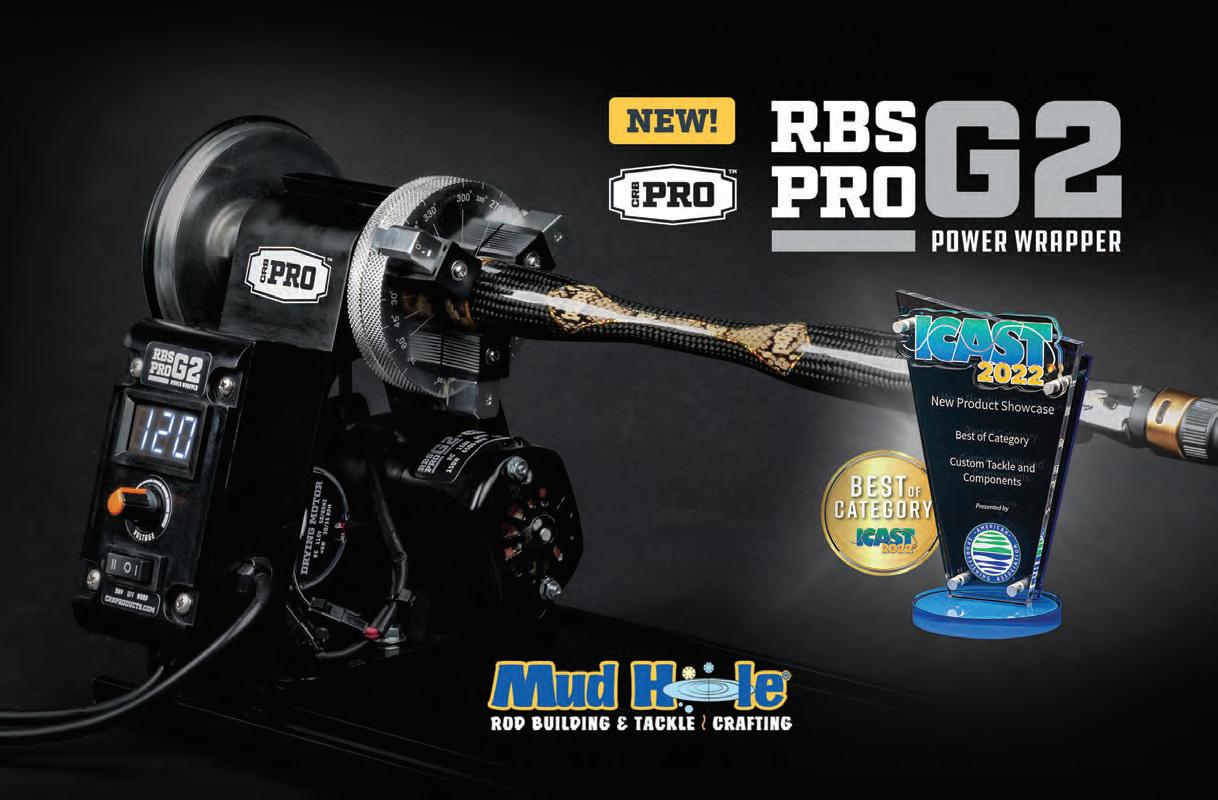


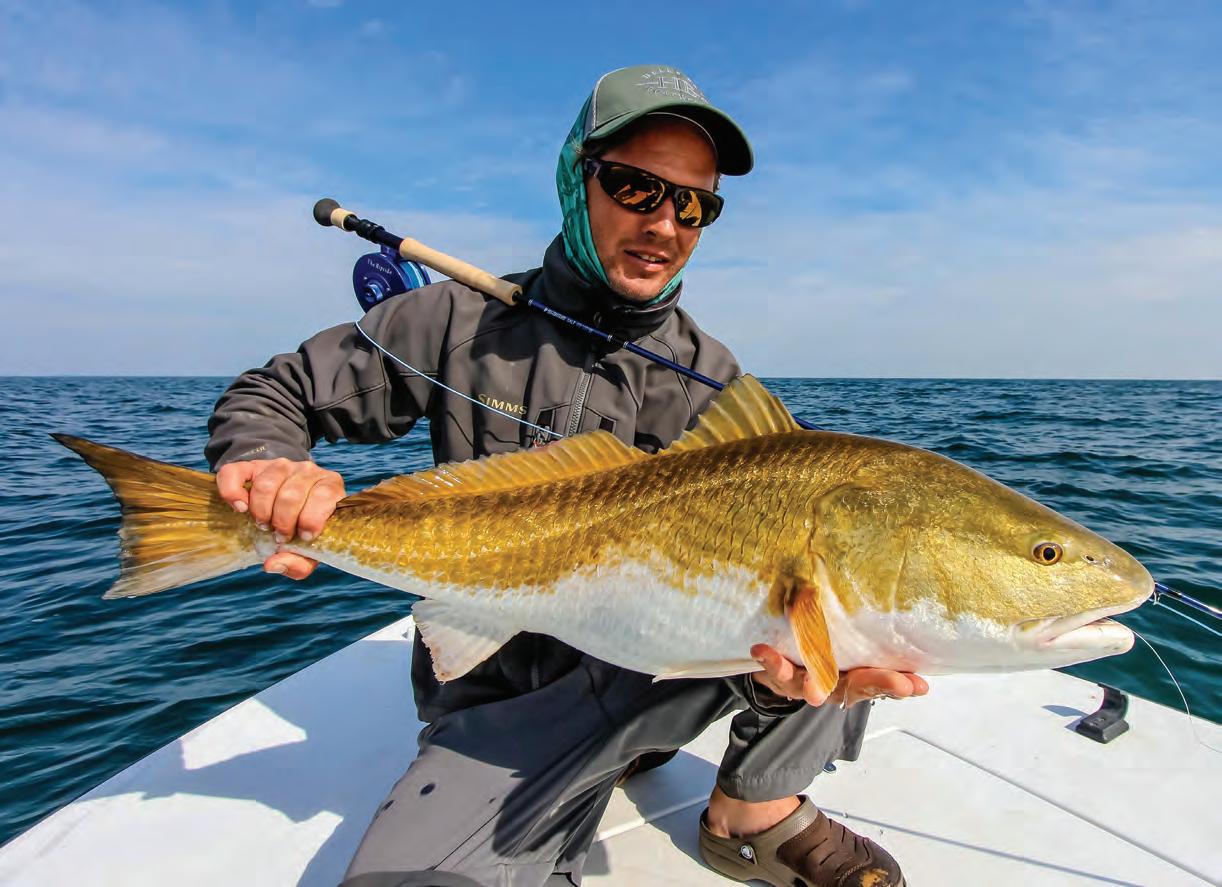 By Capt. Michael Bruner
By Capt. Michael Bruner
In Charleston, S.C., the almighty redfish reigns as king of the flats in our salt marshes. Since tides can get as high as 7 feet, we are presented with options for sight fishing for them. No matter how you approach it, sight fishing for big reds is awesome.
From shallow-water exposed mud flats to flooded spartina grass flats, we choose our approach based on the time and size of the tide, the season and recent trends. Because our tides are so big and span a period of six hours, we are presented with blocks of time in which these flats are fishable.

As these large tides fill our spartina grass flats, so do the redfish. Often referred to as flood tides, these high tides are some of the most popular for sight fishing. Hunting for redfish feeding on fiddler crabs with their tails waving in the air is the approach to these
tides. Flood tides typically happen on new and full moons with the exception of fall months, when they occur more frequently. Fishing two hours before and after high tide, our goal is to target a single fish tailing so that we can feed it a fly or lure. Distance is not as important as accuracy during these tides because the fish will be feeding head down in the mud, allowing the angler to get in close range. Weedless lures and weighted fly patterns with strong weed guards are a must for these flats.

Fishing on the mud flats can be done yearround but is best from late fall into winter. When the fish are spread out rather than swimming in schools, you need both accuracy and distance. However, when fish are in schools, and especially a winter school, you really just need to get the fly or lure in front of the mass without spooking them. They can be sensitive due to harassment from porpoises and pressure. These schools can range from twenty fish to hundreds of fish. You may spot them by searching for wakes, or you
may find them tailing and flashing. During the winter, coastal South Carolina’s water will clear up nicely, allowing us to sight fish in clear water!
At times the fish will bite at a different stage of the tide. Sometimes these trends can be a guaranteed catch. For example, you might catch fish coming out of the grass on a high falling tide that are happy and ferociously eating; or you could spot a giant school of tailing, flashing fish feeding on top in the middle of the summer at low tide! Other trends can be sight fishing for reds in the surf, chasing big schools of giant redfish floating on the surface in the ocean under birds, and maneuvering your way up in the back of a skinny creek to find fish slurping shrimp with nowhere to go. Quite often these trends can be a great way to catch fish. So enjoy the moment because they don’t always happen. Contact
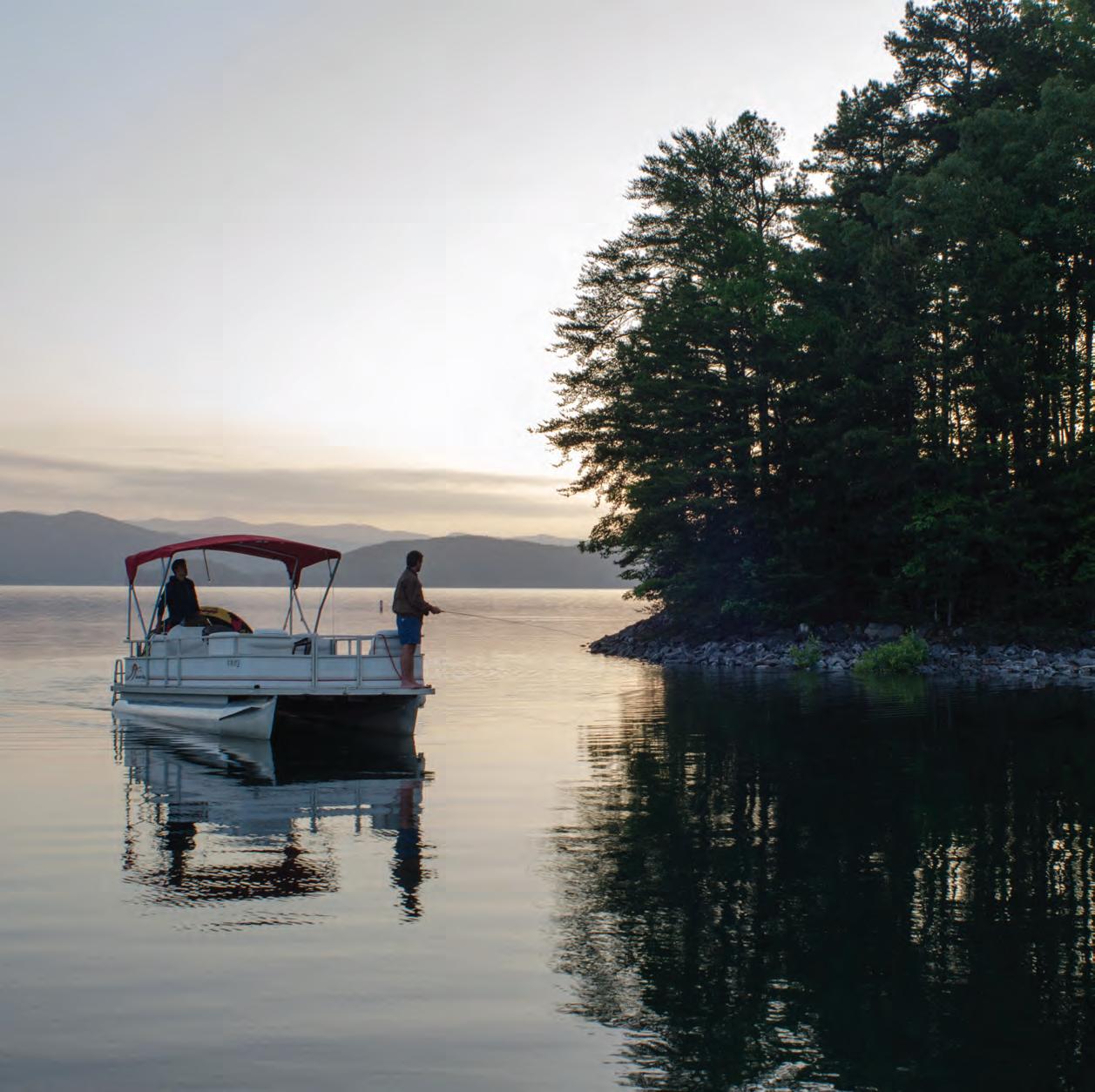











ou don’t need an invitation to have fun in Upcountry South Carolina: Come kayak crys-tal blue lakes, hike to rushing waterfalls, dig into local cuisine, attend family oriented events and breathe fresh mountain air. But when you hold a South Carolina fishing license, it feels like an official ticket to enjoy the great outdoors.
Fish bite year-round in the lakes, rivers and streams of Upcountry South Carolina, which is located in the state’s northwest corner in the foothills of the Blue Ridge Mountains. Devils Fork State Park in Salem is a great place to access Lake Jocassee, which holds state records for rainbow trout, brown trout, redeye bass, smallmouth bass, spotted bass and yellow perch. Or try your luck at Lake Hartwell, at Lake Hartwell State Park in Fair Play and Sadlers Creek State Park in Anderson, three-time host of the Bassmaster Classic.
The Chattooga River boasts healthy wild trout populations and is also regularly stocked by Oconee County’s Walhalla State Fish Hatchery. The Whitewater River above Lower White-water Falls is another great option for wild trout. Lake Keowee, at Keowee-Toxaway State Park in Pickens County, swims with largemouth, smallmouth and spotted bass, crappie, bluegill, yel-low perch, catfish, brown and rainbow trout.
Pick up everything you need—including advice— at local fly shops or book a guided fish-ing trip. Sam Jones, of Jocassee Charters, puts anglers on trophy trout. Buster Green’s Guide Ser-vice reels in stripers, hybrids and bass on Hartwell and Keowee. Chattooga
River Fly Shop leads fly fishing trips on the Chattooga and Chauga rivers.




Even if you don’t fish, you can still get on the water. Jocassee Lake Tours offers tours of the lake and of Jocassee Gorges, which National Geographic called a “destination of a Lifetime.” Some amazing spots can only be reached by boat. Several tours are offered, so you can learn from a naturalist while riding on a pontoon or paddle a kayak through coves and under waterfalls.
Prefer to captain your own boat? There are several rental companies, including TriCounty Boat Rental, on Keowee, Jocassee, Hartwell and other lakes.



If you’d rather be under the water, Jocassee is a world-renowned freshwater diving desti-nation that boasts visibility of more than 50 feet at depth. Lake Jocassee Dive Shop offers lessons and guided trips to see “The Wall,” where a section of mountain was blasted to build the dam, or a 40-foot swimthrough wooden sailboat.
From fishing to boating, hiking to camping, biking to bird watching and more, the Up-country’s state parks are a great place to play. Dip into the swimming hole at Oconee State Park. Hike to the tops of Pinnacle and Table Rock mountains at Table Rock State Park. Explore the 13,000-acre Mountain Bridge Wilderness Area at Caesars Head State Park. Or create your own adventure at any of the Upcountry’s 13 state parks.


Over the next few months, waves of fish will flood the shallows to spawn. This presents the opportunity to catch some monster bass, and a plastic worm is always a main player for me when it comes to the spawn.
A Texas-rigged stickbait is a very common technique, but many people use it inefficiently by casting to a lot of dead water. I try to maximize productivity by casting to high-percentage targets. I focus on isolated cover. In the South, this could be small patches of grass and groups of pads, where spawning females are hidden from the naked eye. In other parts of the country, the structure might be wood or rock. Make multiple casts and work these areas slowly. I use a bigger-style stick bait, normally in the 6” version. Darker colors like a black and blue tip are my go-to. I use lighter 1/16- or 1/8-ounce weights to keep the bait looking natural. Use heavier line to cast around thick cover for large fish, but avoid braid which might be visible to fish in shallow water. I like 17- to 20-pound fluorocarbon.
When I want to cover more water and locate fish, slowly reeling a big speed worm-style bait works great. The vibration the tail gives off
drives fish crazy. It’s an awesome way to find fish before slowing down to pick the area apart. I like darker colors like a junebug when the water has some stain and gravitate to more natural green pumpkin with some flake when the water is cleaner. I use ¼- to 1/8-ounce of weight and 15- to 17-pound fluorocarbon.
A wacky rig is also effective when fish are shallow. I fish it just like the Texas-rig in isolated cover, but I fish it weightless. This is great for heavily pressured fish. I use lighter line in the 10- to 15-pound range and a spinning rod for a wacky rig.

Flipping a worm is the last technique I will cover. This allows you to put a bait in places other styles don’t allow and efficiently pick apart heavy cover. I use a large Senko-style soft plastic, and braided line is a must. I like 3/8 to ¾-ounce of weight, depending on the thickness of the cover. Remember, the only way to set yourself apart is to slow down and put your bait in places nobody else has.
Except for the wacky worm, rod and reel choices for each technique are similar. I like a longer 7’6” medium-heavy to heavy action rod for most worm fishing. The 13 Fishing Omen Series has a few rods that are perfect for the job. I use a faster-speed reel like the Concept A 7:5:1.
For the wacky worm, I like a 7’ 3” spinning rod in medium-heavy. A reel with good drag is important, and I’d recommend the Axum from 13 Fishing.
Used by Bass Master Elite fisherman Brock Mosley and two time back to back Bass Master Classic Champion Hank Cherry, Dakota Lithium is the choice of champions and trusted by professional tournament anglers for those long days on the water.

The Dakota Lithium 36V 63Ah battery will allow you to fish longer with twice the power, half the weight, and four times the lifespan than your old sealed lead acid or AGM batteries –providing exceptional lifetime value. All backed by the Dakota lithium legendary 11 year warranty.
Join the Lithium Revolution now! Use the code coastalangler for 10% off on your next purchase at dakotalithium.com

n cold, rainy, winter days, when most fishermen are happy to stay home dreaming of better weather, a few die-hards gear up and get on the water. In the Southeast, bad weather is striper
weather, my friend, and just the thought of hooking a 15- or 20-pound striped bass is enough to keep you warm on the inside.
Atlantic striped bass get all the attention up north. Blitzing linesiders are a prize of inshore and nearshore recreational fisheries
staple inshore species here, there are fishable striper populations in coastal rivers like the St. Johns, Nassau and St. Marys.
 By Danny Patrick
By Danny Patrick
I, however, was lured by reports a little farther north in Georgia, where rivers like the Satilla and Altamaha are producing bigtime striper fishing with each front that rolls through. Stripers prefer low-light conditions and colder water temps, so overcast, rainy and cold days are the best days.
I was giddy about the cold, foggy drizzle at 6:30 a.m. when I met guide Drew Jones at the Two-Way Fish Camp on the Altamaha near Darien, Ga. Jones runs fishing and duck-hunting charters in the area, and he’s caught more than 300 stripers up to 14 pounds for clients this season. They’ve had some 30- and 40-fish days, and this felt like a perfect striper day!
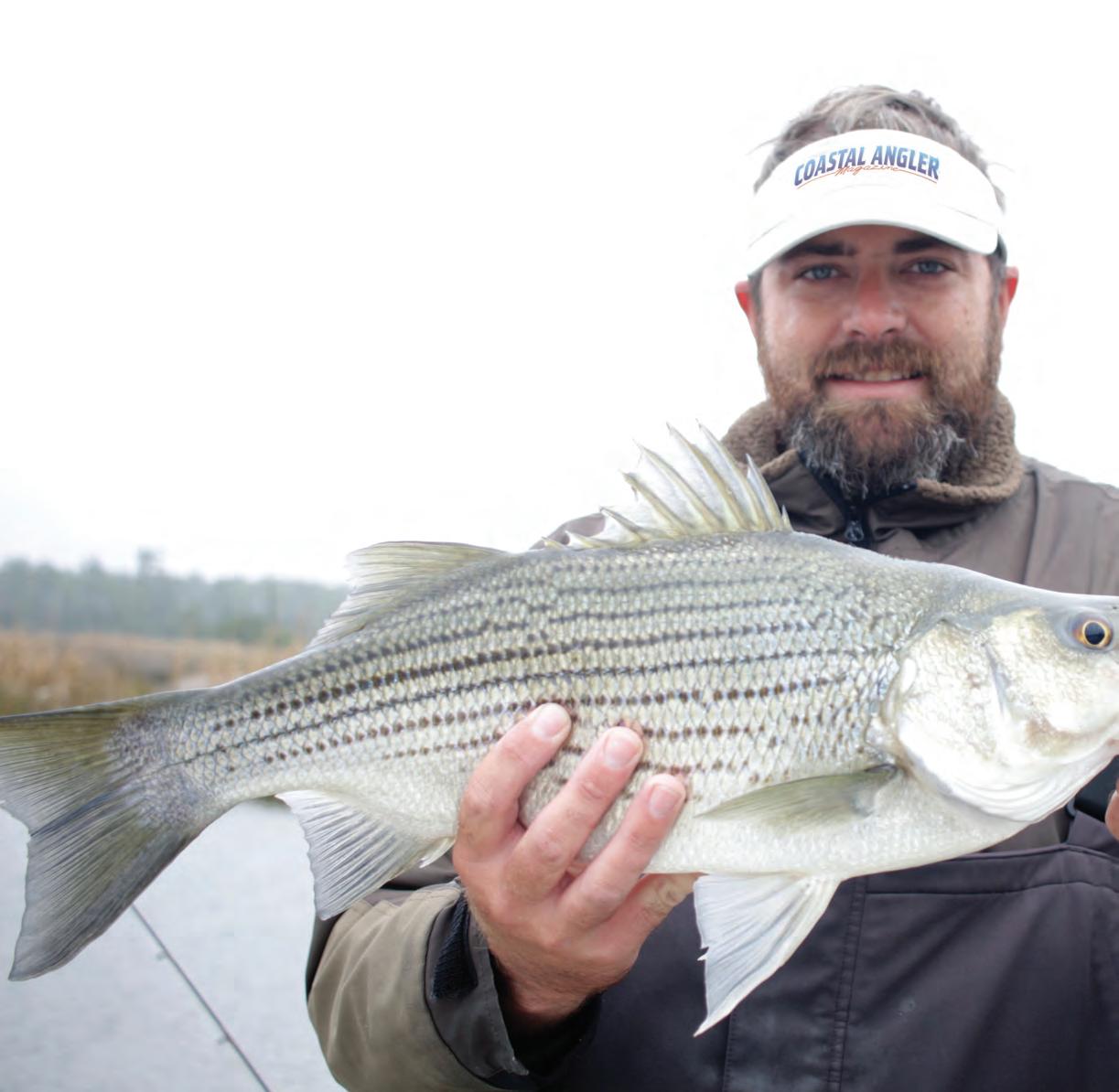
All I had to do was get in the boat with my gear and a thermos of hot coffee. Jones was waiting for me with his Carolina skiff in the water and a livewell full of gorgeous local live shrimp. As we motored off in the mist through creeks and the winding river, he told me a little about the fishing.
Stripers are constantly on the move, and they hunt in packs. Jones drift fishes live shrimp on float rigs to locate concentrations of fish. Then he switches to artificial lures. Slow-sinking stick baits and bucktail jigs with softplastic tails both work great.
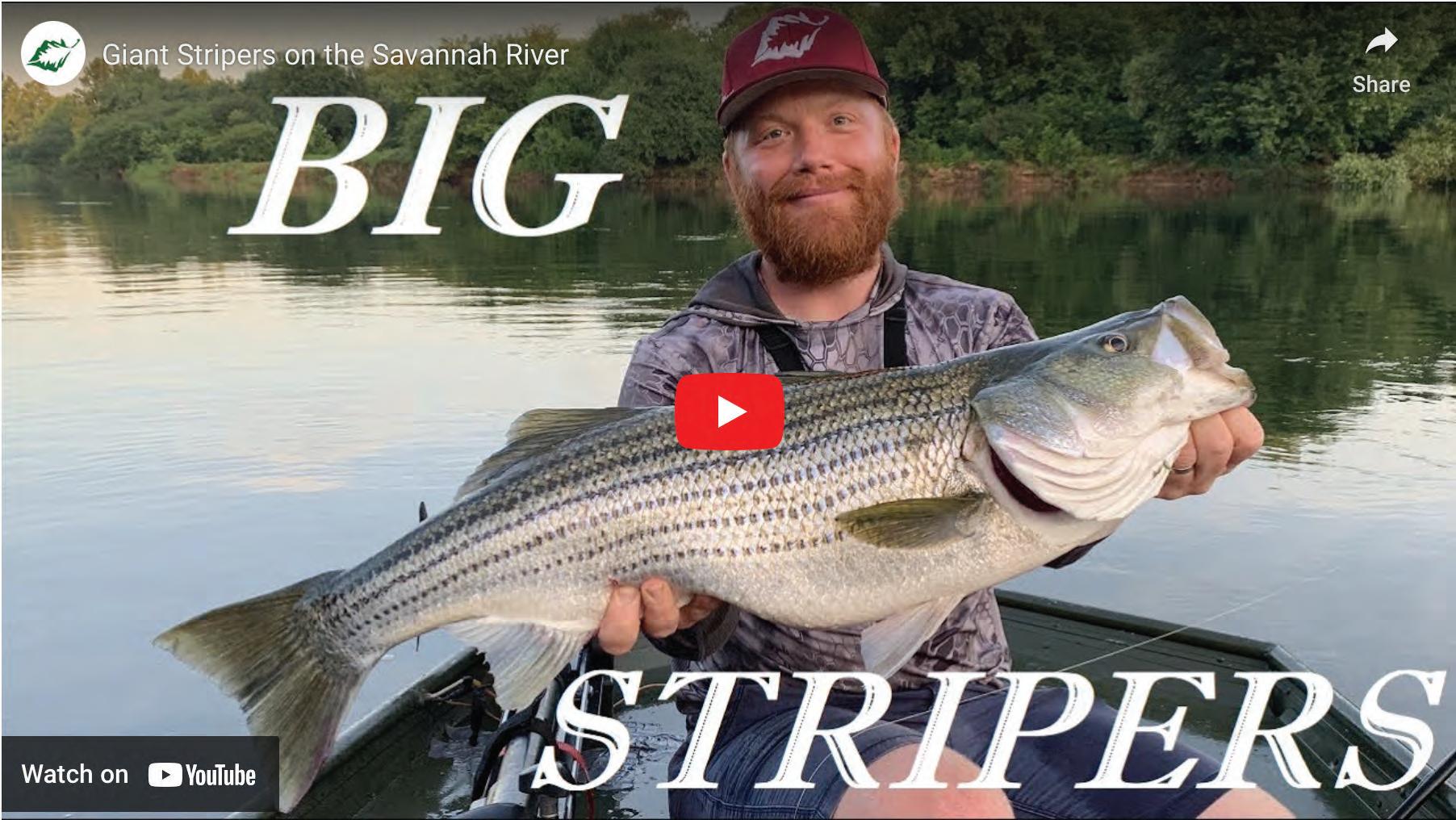

Between Brunswick and Darien, Ga., the Altamaha system is a maze of
creeks and tributaries. We stopped at the mouth of a creek on the Darien River, not far from downtown Darien. The tide was still coming in but slowing near the end of the high tide. Jones said to cast shrimp out in front a point where the current split to create a back eddy of slower flow. He said this was one of his favorite striper spots. It was an old ballast pile, where sailing ships from the 1800s dumped ballast weight from their hulls after crossing the ocean from Europe. They used hundreds, if not thousands, of 10- to 20-pound round rocks to stabilize their ships during the crossing and then dumped the rocks in order to navigate over the shallow sand and mud bars of the river. Georgia’s sounds and rivers are littered with piles of ballast rocks, many of which are fish magnets. We fished the point for a good 20 minutes with no bites before moving up the creek.
Through the early morning, we fished several spots with only a few small redfish and speckled trout to keep our attention. We fished a creek loaded with fishy-looking downed timber and carefully navigated beneath a low bridge, where Jones thought we might find fish on the outgoing tide.
He was correct. Jones hooked up with a nice 6-pound hybrid striped bass on his first cast near the bridge. Hybrids are a hatchery-produced cross between striped bass and white bass. They are unable to reproduce and are an excellent sportfish with the aggression of white bass and some of the size of a striper. These hybrids came from the Georgia DNR hatchery
at Richmond Hill, Ga.
Jones said he catches true stripers and hybrids together, and that sometimes aggressive stripers move in and take over when he’s catching trout. I threw to the same spot Jones caught his fish and immediately hooked and boated a 4-pound hybrid. The bite was on! We saw them busting finger mullet and had one come unbuttoned right at the boat. But then, as is sometimes the case with stripers, it ended as suddenly as it had begun.
So, we picked up anchor and went back to the creek mouth where we started. Now the tide was running out swiftly. We caught several trout and a couple more hybrids before we headed back to the docks.
As we ran past downtown Darien, I saw remnants of old buildings from the 1800s and thought of the history. This was a major port during the early rise of the United States. Cotton and rice from slave plantations were shipped out of Darien, and old-growth cypress trees were logged way up the Altamaha. Loggers would cut trees close to the river and then raft them together in units of dozens of massive logs, which were floated down to the coastal sawmills with men riding the rafts.
Darien is a quiet town now, but it was a truly a bustling place then. It is beautiful with old live oaks and Spanish moss, and history buffs will not be disappointed. If you want to change up your fishing and explore a special place, give Jones a call. He can hook you up…
Capt. Drew Jones can be contacted at (912) 242-2502.







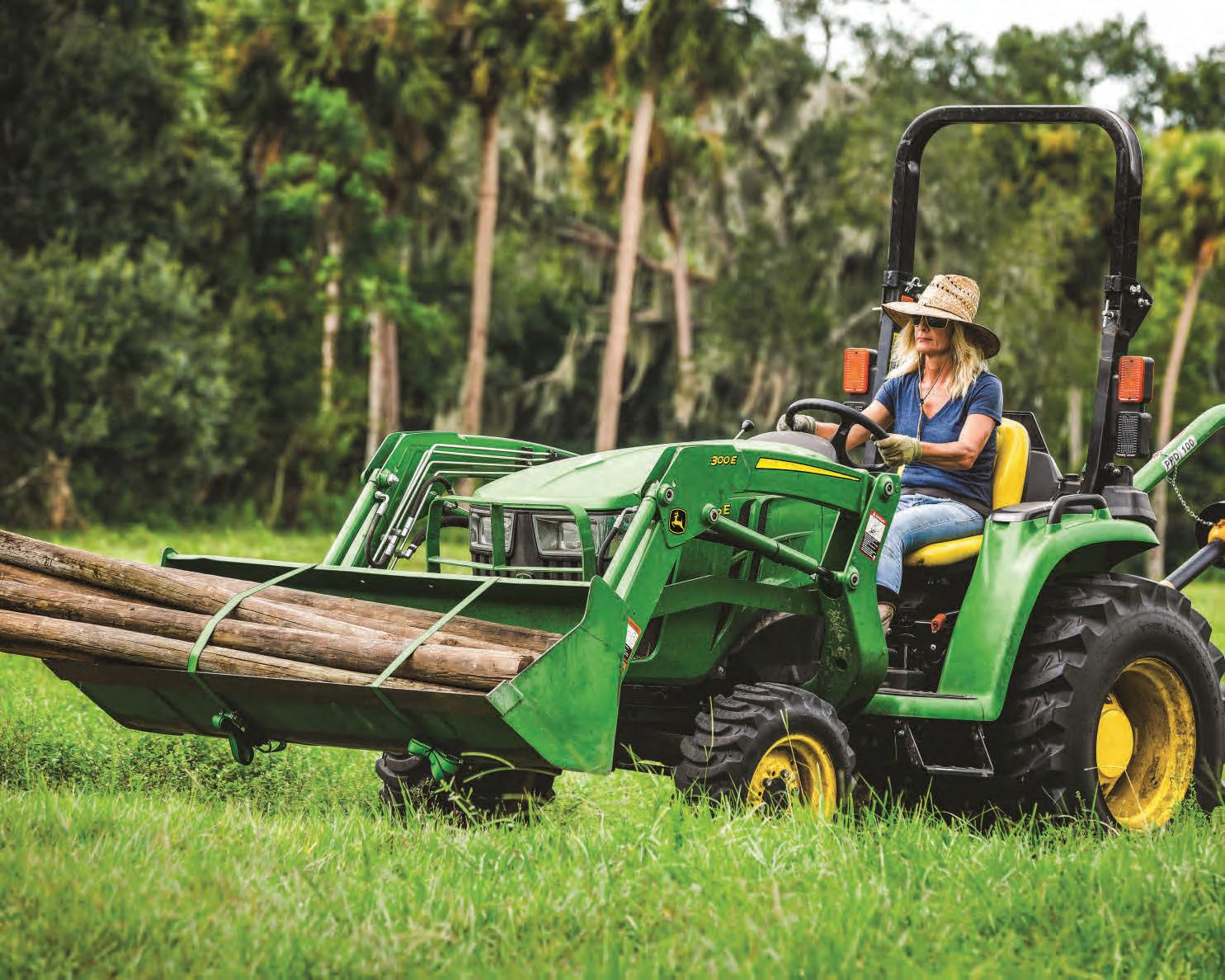
FOR MONTHS 0% 60



 By Emily Rose Hanzlik
By Emily Rose Hanzlik
With the cold fading away, so will the flounder, but they return with spring. Many anglers believe the second cold snap is prime time, when southern flounder begin moving through the inlets. The timing varies greatly, but it can be gangbusters in the inlets if you catch it right. Even if you don’t, there will likely be some stragglers moving through.
Flounder are interesting fish. As hatchlings, they swim upright with eyes on both sides of their heads, just like most fish. As they mature, one eye moves over to the other side of their head and they spend the rest of their lives looking up with one side of their body flat on the bottom.
There are several species of flounder with overlapping ranges. Summer flounder are what northern anglers call flukes, their range in the Atlantic stretches from Nova Scotia down to Florida. Southern flounder inhabit
be found in the Gulf of Mexico from Florida to Texas. Southern flounder can be identified by their white underbelly and an absence of the ocellated spots the other two species have. These spots resemble eyes, which are thought to trick predators. For southern flounder, males don’t grow much longer than 12 inches, while females can reach about 25 inches.
Southern flounder range from North Carolina to Texas, however, they do not migrate besides going offshore for mating and then returning inshore. While inshore, they prefer shallow muddy and grassy flats, where they hide on the bottom and ambush prey.
When the mating season rolls around in late fall and early winter, flounder migrate out of the passes. At the end of winter into early spring, all of the females and some males head back inshore.
Flounder can be caught with artificial and live bait. Artificial lures such as jigs, small swimbaits and spoons worked near the bottom

can all produce fish. Small live bait works the best, with finger mullet being my personal favorite. Small pilchards, mojarra and mud minnows will also do the trick.
Light tackle is all that is needed to catch them. A small weight, 1-ounce, or so, with a short 12- to 16-inch fish-finder rig works best. A live shrimp on a jig head, such as a Troll Rite, jigged along the bottom can also work great and is a good way to cover more area with a live bait.
Some of the best places to find flounder are on inlet rock piles and bridge or pier pilings. Cast upstream and work lures downstream, or let your bait drift downstream.
The IGFA all-tackle record for Southern Flounder is 20 pounds, 9 ounces. It was caught out of Nassau Sound, Fla.
Emily Rose Hanzlik holds 56 IGFA world records in various categories. She hails from West Palm Beach, where she has a part time Bowfin Guide Service as well as fishing classes for Jr. Anglers. Find her on Social Media @ emilyhanzlikoutdoors.


The moment you set foot in London, Kentucky it’s obvious you’ve entered someplace different. In the breathtaking outdoors of Laurel River Lake you get the sense you’re on the verge of something new and at the threshold of an unforgettable adventure. VisitLondonKY.com

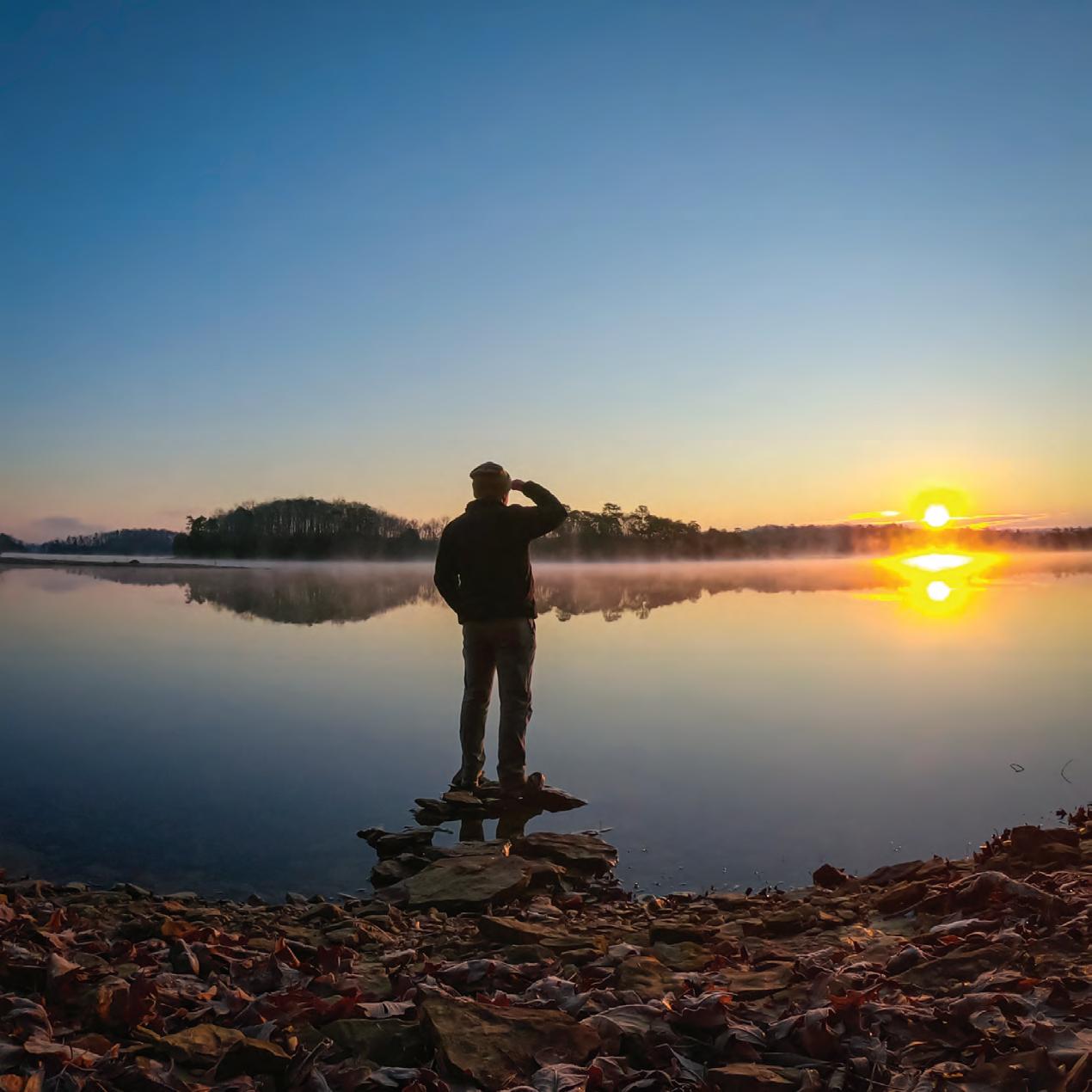





Berkeley County is a wonderland for outdoor enthusiasts, sports buffs, adventure seekers, and water lovers. From exemplary fishing for striped bass, or a trophy largemouth bass, to our hiking trails and water activities, along with scenic outdoors where you can catch a glimpse of white tail deer and gators, Berkeley County has activities to fit all visitors and families.


The waters of Berkeley County, SC, have been a wellspring of natural beauty, culture, and adventure for millennia; people have been coursing the intricate and beautiful waterways of South Carolina’s Lowcountry, with its tall cypresses, sunken forests, and abundant wildlife, for thousands of years.
Twenty-five distinct paddling trails over 235 miles of waterways make up the Berkeley County Blueway system, a hidden world of stunning natural splendor. Packed into this area—the largest paddling trail system in the Southeast—are kayaking and paddling opportunities for all different skill and difficulty levels.
Berkely County lakes make up one of South Carolina’s largest and most beloved freshwater resources. Fishing here is among the best in the state, across the flats of Lake Marion to the open waters of Lake Moultrie. Abundant catfish, bass, and crappie await.
Awaken your sense of adventure in these pristine waters. The Lowcountry is waiting for you at ExploreBerkeleyCounty.com.

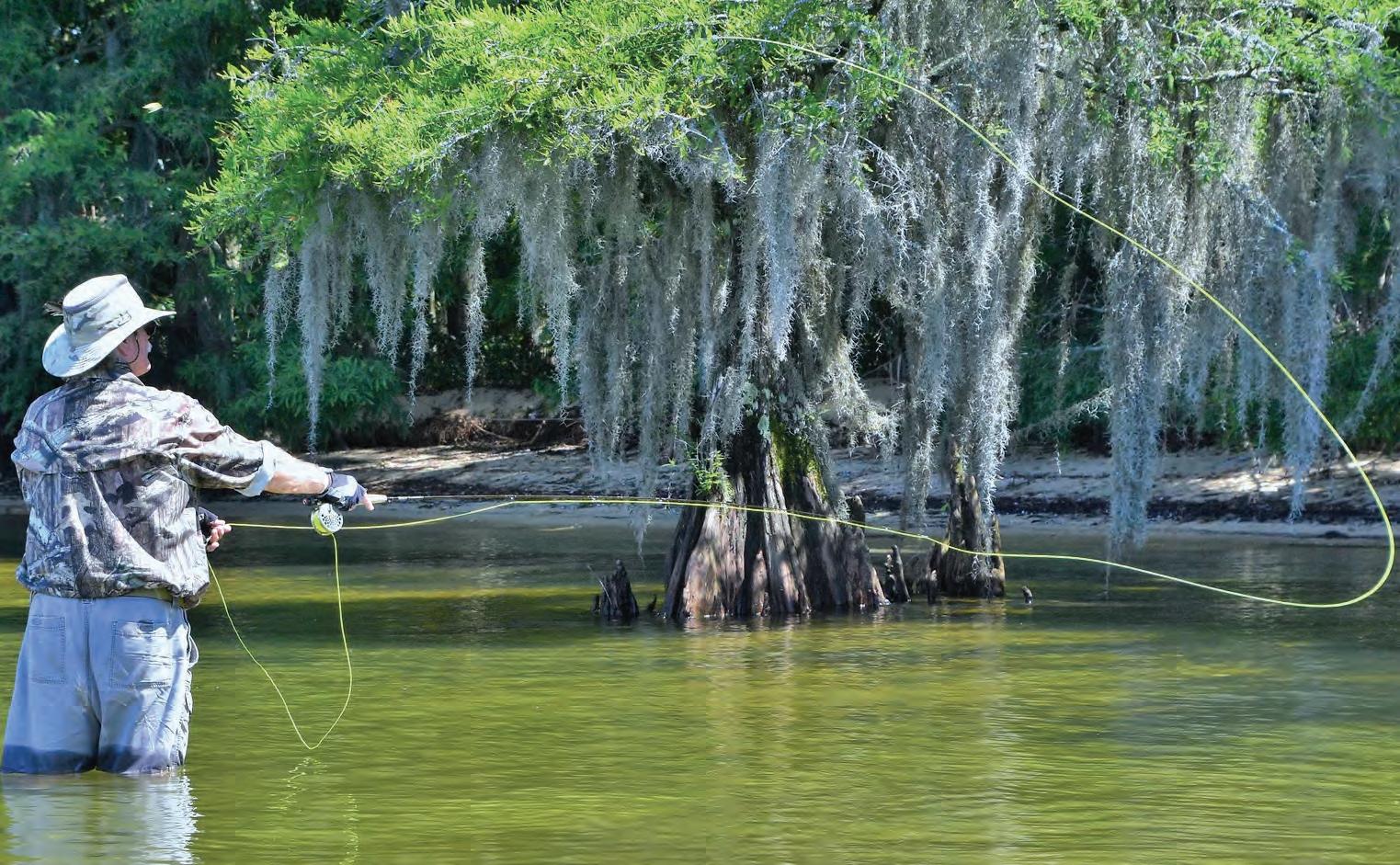

 By David Hulsey
By David Hulsey
Asingle-handed fly rod, which you might refer to as a “normal” fly rod, is the tool of choice for most anglers seeking trout or other species on our inland rivers. But I’m here to tell you there’s a revolution building steam. Don’t be surprised when someone on your local river shows up wielding a twohanded spey rod. These long rods are gaining popularity because they offer certain advantages.
For centuries, two-handed spey gear has been used only in pursuit of big anadromous fish such as salmon or steelhead on the huge coastal rivers of many continents. However, in the last decade or so, micro or trout spey rods have found their way into the hands of anglers. This smaller troutsized spey gear opens the door for fishing areas and for species that inhabit some of our beloved rivers and mediumsized streams.
If it lives in moving water, it can be caught with spey gear. Trout, of course, are the main quarry, but other fish such as smallmouth, spotted bass, largemouth, white bass and stripers are also fair game. Smallersized spey rods in 4-, 3-, or even 2-weight sizes are extremely effective tools for reaching fish in big water with dicey wading areas.
Besides being loads of fun to fish and cast,
a spey rod is designed to launch flies into the next county with little or no back-cast room available. Most trout-sized spey rods are less than 12 feet long, with longer rods up to 16 feet reserved for big steelhead or salmon. A 2-weight spey
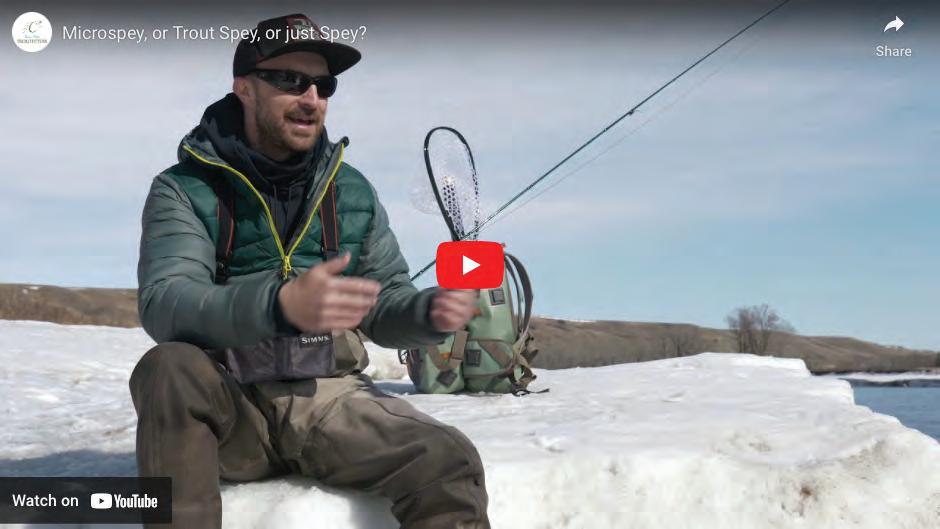

rod is similar to casting a 4or 5-weight single-hand fly rod. A 3-weight spey rod can handle flies in sizes that a 5- or 6-weight single-hand can cast, and so on.
Here’s the main advantage of two-handed gear: Easy casts of 70 or more feet can be launched from positions that are impossible with a single-hand fly rod. Right now, the wheels in your head should be turning about places on your home river you have always wanted to run a fly through but couldn’t reach.
Fishing is done down and across current to carefully swing flies through likely runs or holes, and the angler waits for the electric jolt of a trout or bass. Flies imitating baitfish, emerging insects, and even brightly colored Atlantic salmon or steelhead flies in smaller sizes are readily taken by fish. A well-tied fly sweeping in front of a predator can draw a hunger reaction or a reflex strike in almost any condition.
Casting and fishing micro spey gear is extremely fun and effective. I hope you will join the trout spey revolution!
David Hulsey is a north Georgia guide who also teaches spey and regular fly fishing classes. Contact him through his website at www.hulseyflyfishing.com.


Watauga River
Home of world class fishing on the beautiful Watauga Lake, rugged Doe River and designated trophy trout stream, Watauga River
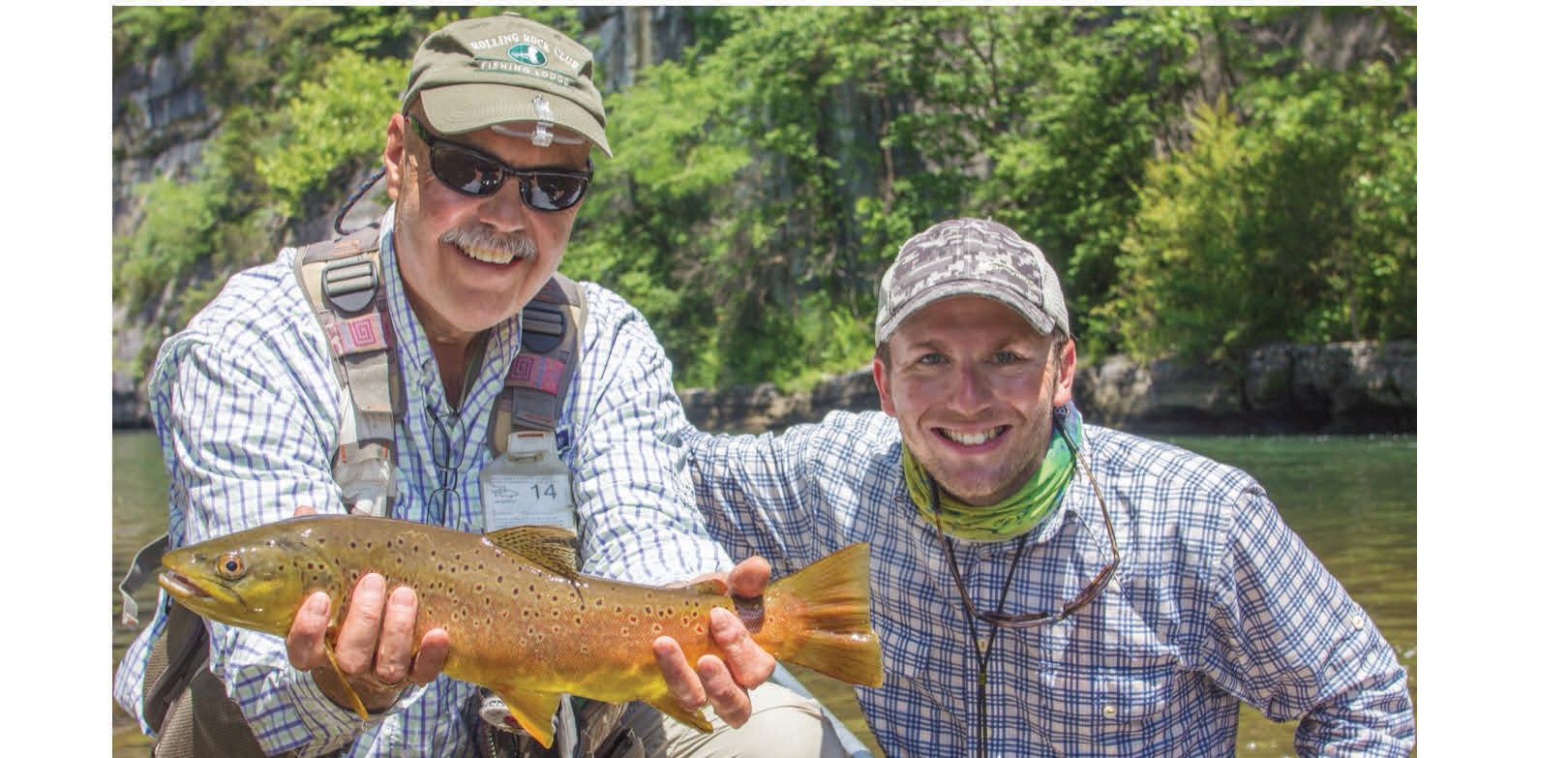
Watauga Lake
Doe River
PLAN YOUR TRIP AT TOURCARTERCOUNTY.COM

















Arare photo of a Big-Fin Squid, caught on camera on November 11th 2007 by a Shell Oil company ROV, at a depth of 2,386 meters (1.5 miles). This species of Squid dwell at extreme depths, and are characterised by their long, thin tentacles. They can reach almost 20ft long when fully grown.

Magnapinna squids are one of the deepsea more ethereal creatures. Little is known of these squid as very few have ever been captured, although over the last decade with the increased usage of remotely operated vehicles (ROV) and submersibles more and more video is emerging of them. They are unusual in both that the fins are up to 90% of the length of the body, i.e. the mantle, and the ridiculously long length of the arms. The squid often will hold some of the arms at a 90˚ angles from the side of the body. Wikipedia has a nice entry on the history of their discovery.
On November 11, 2007., a Shell oil company ROV capture a Magnapinna on video (below) at a depth of 2386 meters (~1.5 miles). Someone (I’ve been unable to track down who created this), used the video to produce a single image of this individual (above). It was subsequently posted to Reddit. Love the image of this fascinating creature.



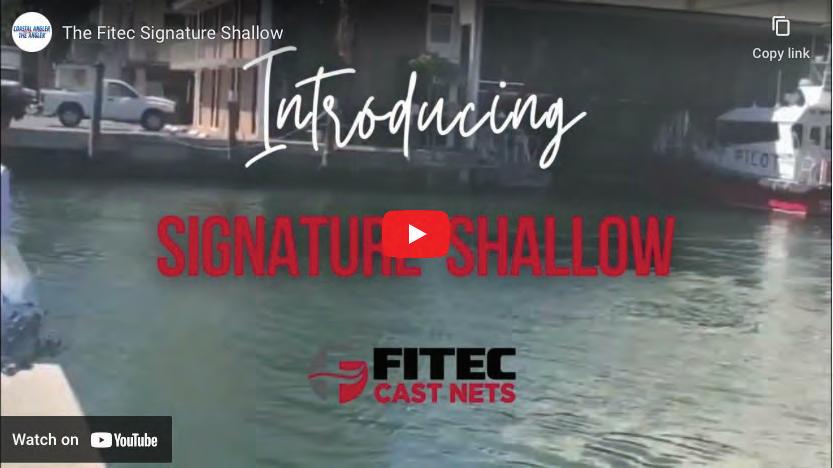

Kendale Jeans, of Elberta, Alabama caught a 16-pound, 6.6-ounce sheepshead
Alabama saltwater anglers have been on a record-setting pace with 11 fish entering the record books from October 2021 to October 2022, and two of those records remained on the books for only months.
Scott Bannon, Marine Resources Division Director with the Alabama Department of Conservation and Natural Resources, said the only year that compares with the recent spate of record fish is 2006, when 13 records were set.
“When I looked at the number of records, what was interesting was that two of them were broken twice,” Bannon said of the sheepshead and permit categories. “That’s kind of unique over our history. I think several things contribute to that. If you look at the number of license sales and boat sales, there are more people taking advantage of the fishing opportunities we have in Alabama. That means more people on the water, more trips on the water, so there are more opportunities to break these state records.
“In addition to that, you’re really seeing people begin to do more of these deep drops and more offshore trips with better electronics. Boats are more efficient. There are confidence levels and safety with more people going offshore, so we’re seeing these fish that we haven’t seen historically. I think this is great news for Alabama. I think it shows the benefits of having such a great saltwater fishery, both inshore species and offshore species.”
One species familiar with Alabama anglers that had the record broken twice was sheepshead. Wesley Olsen landed a huge sheepshead that weighed 14 pounds, 4 ounces, but it didn’t stay on top long. Kendale Jeans
to set the new Alabama state record. She was fishing a spillway with her husband, Donovan, when the monster convict fish ate a live shrimp. Kendale fought the
big fish on 10-pound test using her new Zebco 33 and credited God and her husband’s coaching for helping her land the fish after an epic fight.
reeled in a monster sheepshead that hit the scales at 16 pounds, 6.6 ounces.
The other twice-broken record came from a fish not seen as often, permit, a cousin of the Florida pompano in the jack family. Pompano and permit look very much alike, although pompano don’t grow nearly as large, topping out at around seven pounds. Permit weighing 20 pounds are fairly common in south Florida.
Annalise Wilson set the Alabama record in October 2021 with a permit that weighed 6 pounds, 0.54 ounces. In August 2022, Patrick Willis landed a permit that weighed 8 pounds, 2.4 ounces.
“Historically, we haven’t seen as many permit, but I think now people are starting to target them and pompano more often,” Bannon said. “I think that’s a product of social media, where people are sharing their fishing tips, how to rig for these type fish and where to fish for them.
“That’s good and bad. There is higher effort on these species, but I believe that could be because of the cost of fuel. More people are taking inshore or closer-to-the-beach trips.”
The prime time to catch sheepshead in Alabama is fast approaching. Sheepshead spawn in the nearshore waters during the early spring before scattering. Before the spawn, the fish hang around inshore structure and feed on barnacles and other crustaceans. Sheepshead are often found around rock and concrete jetties and pilings as well as petroleum platforms, bridges and oyster reefs. Sheepshead
have some serious front teeth to chisel barnacles off structure and to crack crustacean shells.
“Those are two big sheepshead,” Bannon said. “It’s amazing to see two big sheepshead like that, but that 16-pounder is an extraordinary fish. I don’t know, maybe we’ll start seeing more of these extraordinary fish with more people learning how to fish for these species. People are learning to fish more specific and not as generic.”
Another record fish was Chase Mitchell’s jolthead porgy that weighed 9 pounds, 2.88 ounces.
“The porgy is a fish we’ve never had a category for before last year, when the record was established,” Bannon said. “Now that record has been broken. Again, I think it’s because of the change in effort, style of fishing and areas being fished.”
Also going into the Alabama record books is a black jack caught by William Atkins at 13 pounds, 1.6 ounces; a blackline tilefish caught by Gavin Dunnam at 1 pound, 6.4 ounces; a horse-eye jack caught by Bennie Goldman Jr. at 30 pounds, 4 ounces; a red cornetfish caught by Wayne Akin at 2 pounds, 5.4 ounces; a silvery John Dory caught by Mark Russo at 5 pounds, 0.28 ounces; and a lizardfish caught by Nelson Wingo at 1 pound, 11.2 ounces.
For more from David Ranier, see his weekly column at www.outdooralabama.com.
By David Rainer, ADCNR

Bringing 'Everything Fishing' And Some!

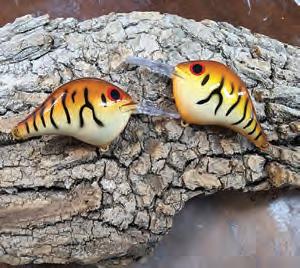

Our sister, The East Tennessee Fishing Show & Expo hosts the largest gathered selection of fishing boats, tackle, kayaks, custom lures, rods, reels, apparel, marine electronics, fishing accessories, and more! – We have taken a few pages from her playbook, and we have brought them down to Gadsden, Alabama where we will be bringing the very first Alabama Fishing Show & Expo!
We ONLY host vendors with fishing, marine, and lake/salt-life related products! Many of our vendors offer multi-species gear for fresh or salt water! We welcome any and all vendors who might have that ‘next BIG thing’!

We try to make sure there is something for every kind of fisherman that attends our event!


We are also sure to include a huge selection of boats and kayaks too, as we try to make it as easy as possible to shop for the newest salt/fresh water fishing boats, gear, and accessories from many reputable and top-notch marine dealers in the greater local and regional Alabama area.
Pro Anglers & Special Guests
One Venue: Everything Fishing!
Bringing Hundreds Of Vendors
MILITARY & FIRST RESPONDERS DAY
Friday March 10th 10:00am - 7:30pm
JUNIOR ANGLERS DAY
Saturday March 11th 10:00am -7:30pm
FINAL DAY OF EVENT
Sunday March 12th 10:00am - 5:00pm
The newest in fiberglass and aluminum fishing boats, tackle, kayaks, custom lures, rods, reels, apparel, marine electronics, fishing accessories, and more! That barely gets us started.



COME SEE US MARCH 10TH-12TH, 2023 AT THE VENUE AT COOSA LANDING!


Idaho’s Joey Walton had been looking for a record smallmouth on Dworshak Reservoir for months. He had already caught several this season that were just shy of the current record, and on Dec. 13 his hard work paid off with a 23.75-inch giant that is the new Idaho catch-and-release state record.

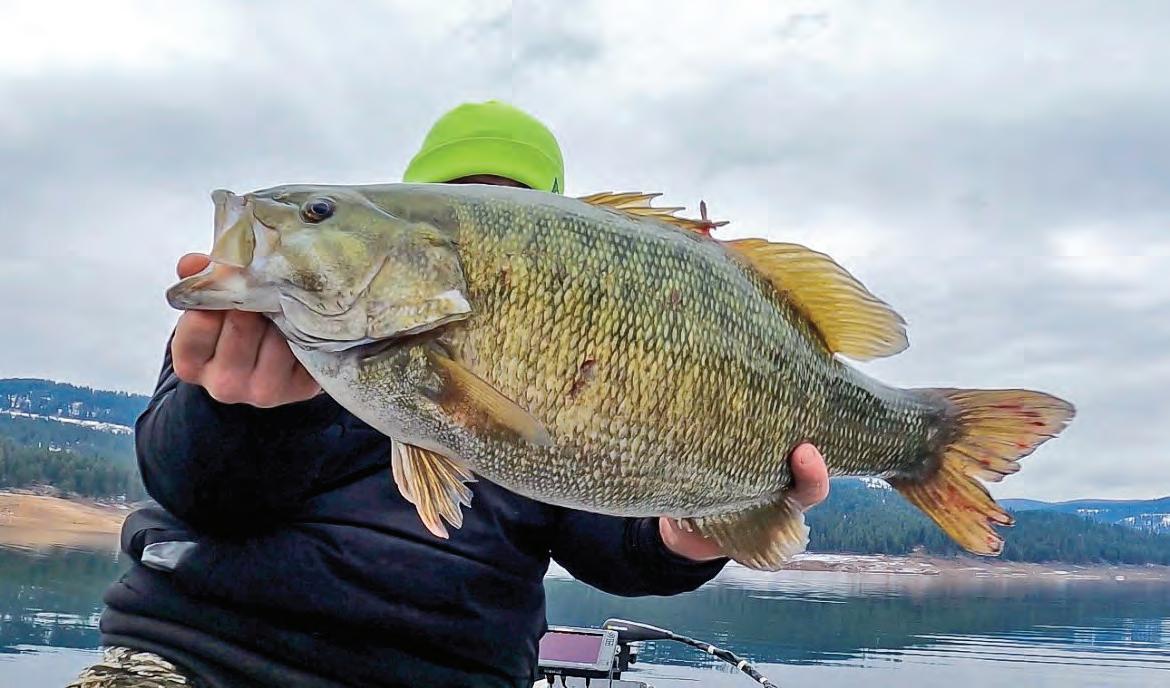
Walton weighed the chunky bronzeback with digital scales on the boat. At 9.1 pounds, the fish came up shy of the 9.72-pound existing weight record, which was caught by Dan Steiger in 2006.
The year 2022 might be remembered as one of the best for Dworshak Reservoir. Dworshak is a large western Idaho reservoir that has produced a string of impressive smallmouth bass recently. Idaho Department of Fish and Game biologists explained that big bass in the lake have a cyclical pattern related to fluctuating numbers of kokanee salmon in the reservoir. In years when kokanee are abundant— and usually smaller as a
they provide ample food to grow supersized smallmouths. Over the last two years, biologists have seen an abundance of kokanee. If conditions remain consistent, there could be another record coming.
For more information, go to https://idfg.idaho.gov.

This is an easy fly pattern to tie – much like the Copper John. The abdomen ribbing effect comes from using two colors of fine colored wire, one bright color and one a contrasting dark color. The thorax is dubbed. Goose biots provide the forked tail and two legs on each side of the thorax. A bead head is prescribed but may be omitted if some underbody of substitute lead is used for weighting under the thorax. The two wires provide some weight regardless.
Actual stonefly nymphs are typically, black, brown or rusty brown, and golden or tan in larger siz-es (4-12) as well as black, yellow, and green in smaller sizes (14-18). For example, a Black
Two Wired Stonefly Nymph may have an abdomen ribbed with hot orange wire and black wire; UTC medium. The tiny winter black stonefly nymphs would be imitated with UTC small wire of the same colors. A Brown Two
By Tom Adams and Alen BakerWired Stonefly Nymph may have an abdomen ribbed with silver wire and amber or rust wire; UTC medium. A Golden Two Wired Stonefly Nymph may have an abdo-men ribbed with hot yellow wire and copper wire; UTC medium. The little yellow and little green stonefly nymphs would be imitated with UTC small wire of the same colors as the larger golden stonefly.
The amount of weight determines how fast the nymph fly pattern will sink toward the bottom. The slowest rate may be achieved by omitting the bead and depending only on the two wires of the ab-domen. The fastest rate may be achieved with a tungsten bead. White goose biots may be used to make the nymph fly pattern stand out on a dark bottom but typically the goose biots color is natu-rally matched to the color of the nymph.
In North Carolina mountain streams, the golden stonefly
nymph is highly effective, thus the hot yellow and copper wire combination is a good choice.
Two Wired Stonefly Nymph
Hook: Nymph hook
Size: 6,8,10,12,14,16

Thread: 8/0 to match body
Tail: Goose Biots to match pattern
Abdomen: Two alternate colors of UTC wire to match pattern
Wings: Goose Biots to match pattern


Thorax Dub: Buggy to match pattern
Directions: Detailed tying steps may be found at the Rocky River Chapter of Trout Unlimited at www.rockyrivertu.org/dry-flypatterns.html.
With big trout on my mind, I hooked up the boat and headed to deep south Texas. An approaching cold front was going to shorten my trip to a single day, but I felt confident it would be worth the 5-hour drive. As the cold front swept across north Texas, my anticipation was high as I headed south to warmer temperatures and extra hours before the frigid air and high-powered north wind turned a nice winter’s day into artic conditions.
The morning greeted me with calm winds and dense fog, which is not typical south Texas weather 14 hours prior to the strongest cold front of the year. The norm is 25 knots from the south or southeast with a storm of this magnitude on the doorstep.
I headed to my pre-determined location at a safe speed considering the conditions. I was in no hurry, as the prime bite was not until 10 a.m. The forecast was sunny, calm and 70 degrees for the day,
followed by north at 35 knots and a low of 28 the next morning. I was certain the approaching weather would have the bite fired up, and it did not disappoint. The fish didn’t feed on everything I tied on, but once I homed in on what they wanted it was nonstop!
I pulled up to a favorite cove, positioned the boat well outside the prime area and quietly slipped into air-clear, knee-deep water of the grass flat. I had a 5-inch paddletail ready at the end of my rod. After covering the prime area with only one follow by a small red, it was time to change. I downsized to a 3.25-inch paddletail with a light purple back and a pearl belly. As I looked up after rigging my lure, I spotted a huge trout about 5 yards in front of me. She was there for several seconds and then slowly disappeared. I knew she was aware of my presence even though she didn’t spook, and I didn’t have high hopes of catching her, but I did try. I was excited knowing my plan had me in
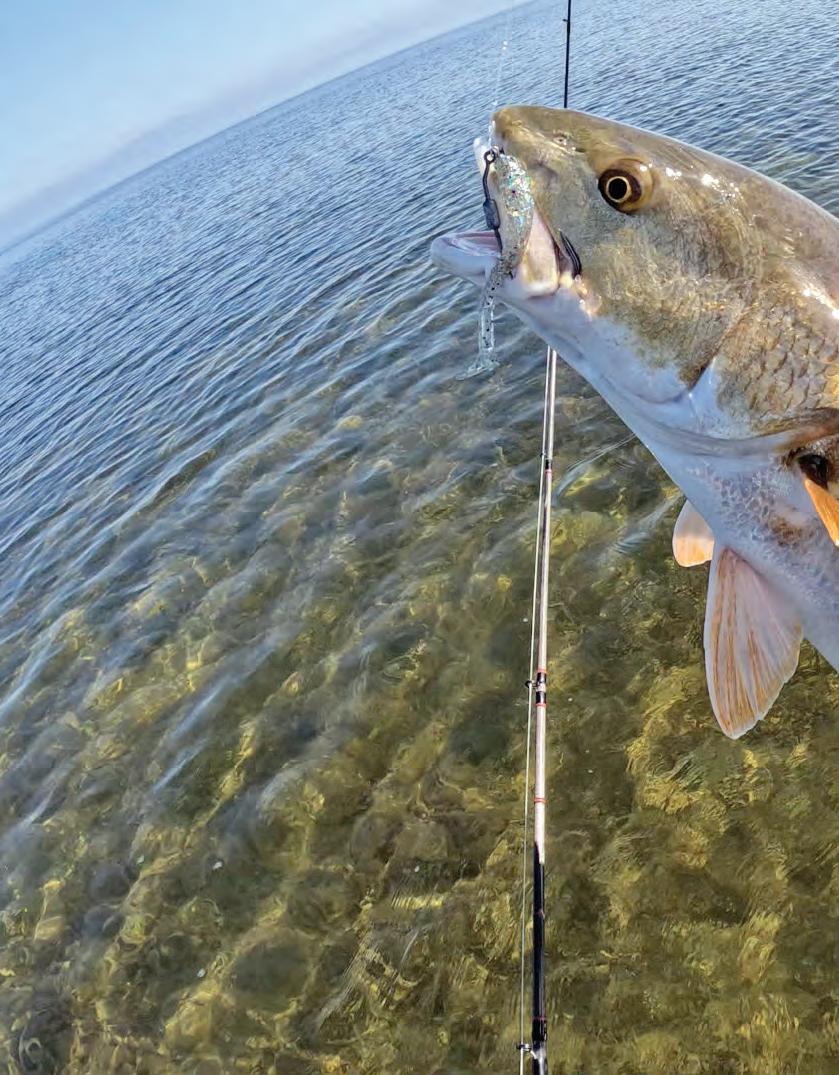
the area of the trophy-size trout I was targeting.

I noticed nervous mullet about 40 yards away and slowly made my way in that direction. It was nonstop action on reds in the 26-inch range, and I caught one 3-pound trout. These fish were a little deeper in thigh-deep, crystal-clear water over grass and potholes.
Throughout the day, I tossed three sizes of similar body-style paddletails, all with built-in tail rattles. The smallest, a 3.25-inch lure, was the only one that caught fish. I used three different colors, so it was only the size that mattered on this day under pre-front conditions. Although I did not land the big trout I was targeting, I am satisfied that I was in the right place and will go back soon.
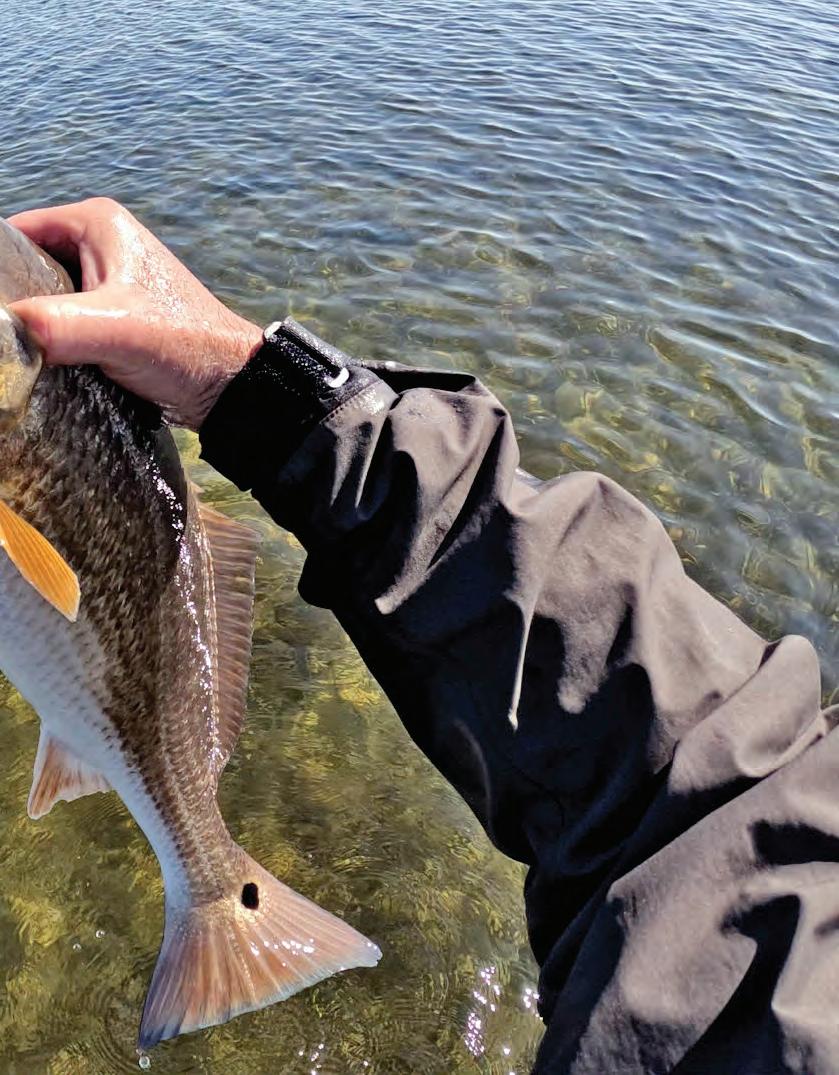


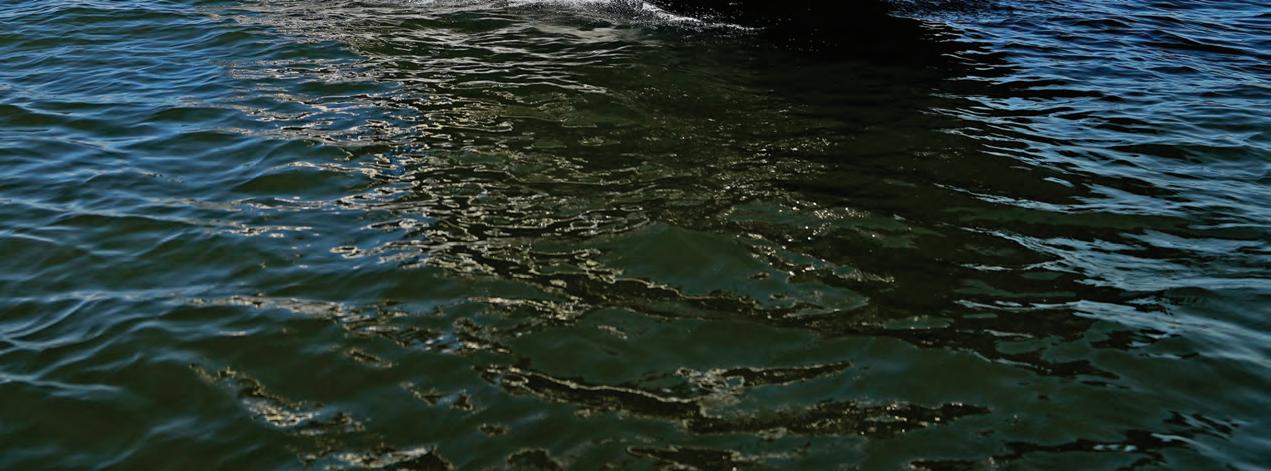








The sliding cork has been, and always will be, one of the most effective tools in any fisherman’s arsenal. Of course, we grew up fishing for everything from crappie to speckled trout and catfish under a sliding cork, with live and cut bait, but now I have incorporated artificial baits into the mix under the sliding cork.
For example, I have a rocky bottom area that’s 9 feet deep on high water, and a D.O.A. Shrimp set 7 feet deep is extremely effective on trout and red drum using this method. First and foremost, you don’t stay hung up in the rocks and oysters. It keeps the shrimp in the “strike zone,” and it drifts at the exact speed of the tide. It’s also a great way to cover a large area using the tide to take your bait as far away as you want to let it go. You can’t possibly cast a bait as far as you can let it drift. We’ve caught several hundred trout at this place over the years with live shrimp, but I’ve switched over to the artificial shrimp for convenience.




The sliding cork has long been our weapon of choice for making long drifts down the river for catfish and striped bass. It’s a great way to locate an area that’s holding fish. Once you start getting bites in an area along the drift, you can concentrate efforts where the fish are. One of my favorite places
to do this is a stretch of river that’s 16 feet deep for a quarter mile. We’ll set the cork at 14 feet and fish the entire stretch very effectively without getting hung up. The sliding cork keeps the bait at the perfect depth and speed.
under or start moving away.

This is also deadly effective on shallowwater grouper. There are areas along the west coast of Florida that hold grouper in very shallow water. You can’t get right on top of these fish to “bottom fish,” and I prefer this more quiet approach as opposed to trolling. Get up-current or up-wind from a rock and drift a nice bait back to them. When you see the float go under, get the fish in quickly or they will run into structure and break you off.

Note: Keep an eye on the position of your cork. It will stay upright as the weight keeps tension on it. If you see the float lay over, it means you just had a bite, because a lot of the bites are from fish rising to eat the bait. Shortly after that is when you see the float go
I’ve said all the above to say this: A sliding cork has application for dozens, if not hundreds, of places and species of fish.

This is the kind of money that makes you wish there was a bounty on bluegills or crappie. In the Pacific Northwest, one angler was paid nearly $70,000 in bounty money for spending the summer catching northern pikeminnows from the Columbia or Snake rivers.
That angler took part in the Northern Pikeminnow Sport Reward Program, which is a bounty program that runs May through September each year and pays anglers for each pikeminnow longer than 9 inches they catch and keep. It’s an interesting management strategy considering pikeminnows are native to the Columbia and Snake rivers. The goal is not to eradicate the fish but to keep their numbers in check ahead of the salmon and steelhead spawn, which occurs October through December each year. Pikeminnows are voracious predators of juvenile salmon and steelhead.
In 2022, anglers were paid $6 each for the first 25 fish they turned in; $8 each for 26 to 200 pikeminnows; and $10 for each fish after 200. There are also tagged pikeminnows in the rivers worth up to $500 each. The top earner for 2022 collected more than 7,000 fish to earn $69,230. The second highest bounty paid was $63,700. Nearly 1,200 people registered for the program in 2022 and turned in 140,121 pikeminnows. Nearly $1.4 million in bounty dollars were paid. Those are pretty amazing numbers
considering the anglers were hook-and-line fishing. Tactics for pikeminnow are similar to those employed by catfish anglers. Pikeminnows frequently fall victim to baits like chicken liver, stinky cheese or nightcrawlers fished on the bottom.

But before you book an Oregon Airbnb for the entirety of next summer, realize that the pikeminnow fishery is just like any other, in that 80 percent of the fish are caught by 10 percent of the anglers. With that kind of money on the line, you can bet everyone’s holding their secrets close to their chests.


Since 1991, the program has removed about 5.4 million pikeminnows from the Columbia and Snake. Biologists say the annual catch is 10 to 20 percent of the estimated pikeminnow population and that it has reduced predation on salmon and steelhead by up to 40 percent.
The Pacific States Marine Fisheries Commission, the Washington Department of Fish and Wildlife, and the Oregon Department of Fish and Wildlife collaboratively manage the program.
For more information, visit www.pikeminnow.org.
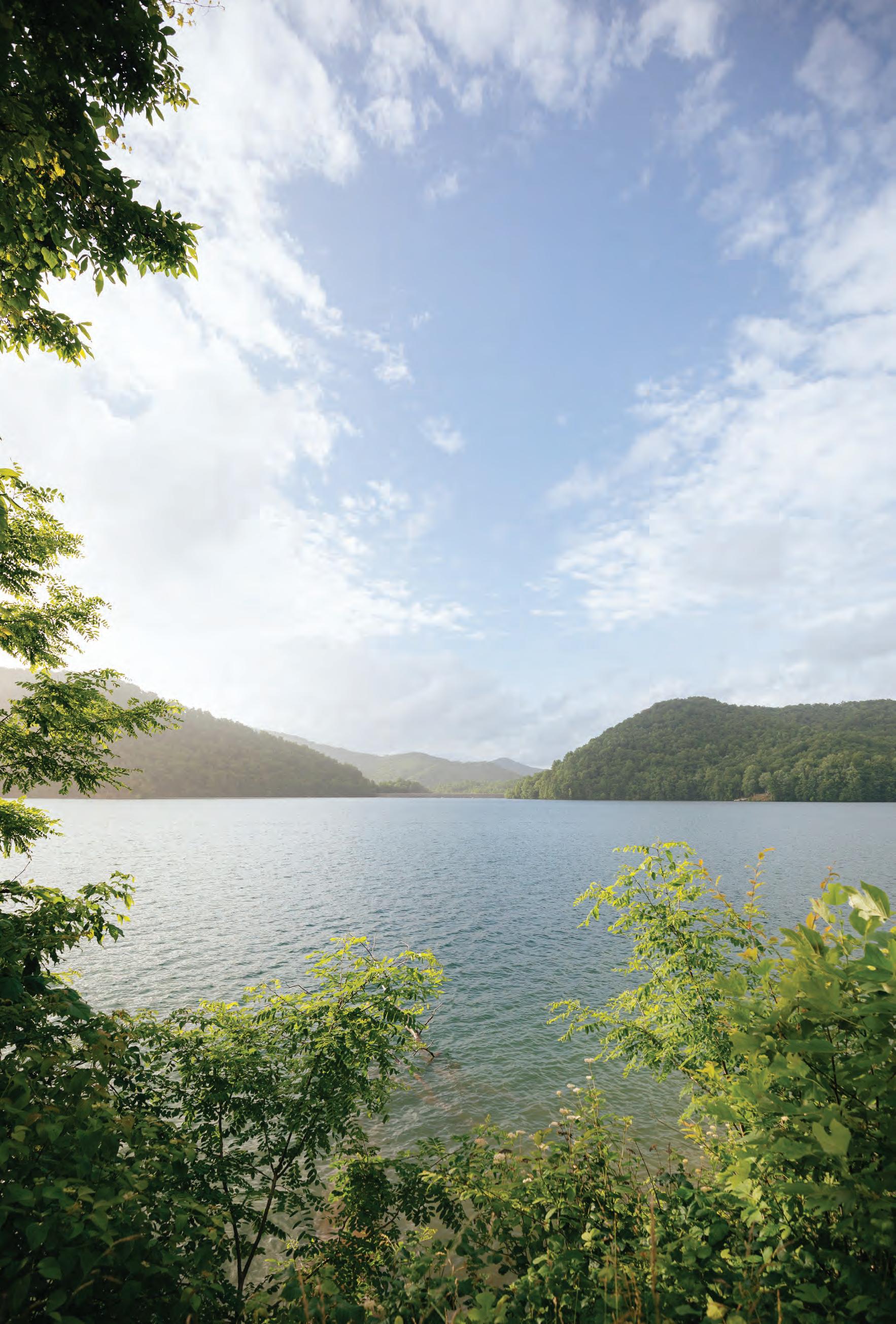

Situated riverfront and surrounded by the natural springs of King’s Bay, Plantation on Crystal River is an ideal setting for travelers of all ages and interests to enjoy endless outdoor activities. From boating and fishing to scalloping and wildlife encounters, visitors from around the globe travel to Florida’s Nature Coast to enjoy the organic assets of this dynamic destination. And before or after these unique activities, guests can enjoy the full-service restaurant, lobby bar and tiki bar conveniently located on property. For international travelers, transportation is convenient with nearby international airports, including Tampa International Airport only 70 miles away, and Orlando International airport just 90 miles away. To follow is just a sampling of the abundance of available outdoor pursuits.

Monday: Sangria Monday – Enjoy our featured sangria of the month for just $7. February's Flavor: Raspberry Rose.
Tuesday: Tequila Tuesday - $8 for our featured tequila of the month (no substitutions). February's Tequila: Salt Chocolate.
Wednesday: Wine Wednesday - $10 off any bottle of wine with dinner purchase.
Thursday: Thirsty Thursday – Take $2 off any of Plantation’s Signature Cocktails or Glasses of Wine. Featuring the soulful Louie Fortunato live entertainment.
• Get 15% off now through 4/15/2023
• Sunday – Thursday 11/28/22 through 4/15/2023
(excluding Holidays and special events)





 By Tom Karrow
By Tom Karrow
In previous issues of this magazine, I have chronicled my travels and research on Grand Bahama for Ghost Stories, a research project on the history of Bahamian bonefishing. This edition will be focused on DIY angling on Grand Bahama.
While conducting interviews from the West End all the way to McLeans Town and Deep Water Cay in the east, I had the great fortune of wetting a line. Although I travelled unused logging roads to the north side of the island to explore the pristine habitat, all of my angling took place on the more accessible south shore.
The south side of Grand Bahama provides a plethora of angling opportunities both inshore and offshore. Coral reefs extend the length of this southern shore, providing refuge from pounding surf for many inshore species. These reefs give anglers chances from shore for a mixed bag including, bonefish, permit, barracuda, triggerfish and a host of other “reef” fish.
While I found large schools of bonefish in the West End area, it is the eastern end of the island that offers more extensive, less developed flats and consequently more fish. Stunningly beautiful blue holes dot the southern shoreline, and these geological marvels provide vital nutrients, safety, and critical key water temperatures for fish when conditions are extreme.
Flats on the south side are fairly narrow, constrained by the reef and deep water, and therefore easier to fish than typical expansive Bahamian flats. Shoreline substrates vary from smooth sand to grassy and rocky broken bottoms. Wading boots are a must for safety. My R.L. Winston Boron 8-weight and Nautilus reel performed flawlessly in all of these conditions, and many bonefish were subdued as well as other species. Typical 12-foot fluorocarbon leaders worked well. I prefer fluorocarbon for its abrasion resistance, sink rate, and because the water is crystal clear. Standard size 2 and 4 bonefish flies like Gotchas and Charlies caught
fish. A mix of colors are needed to suit the varied bottom, and differing weights are also critical to ensure flies are near the bottom, regardless of the depth and tide phase. I found tan, olive and gold colors worked well, and I was glad to have some tiny flies (sizes 6, 8 and even 10) for the ever-present and challenging triggerfish.
The south side of Grand Bahama is almost a guaranteed place to find fish. Anglers with a desire to explore will likely be all on their own, walking stunningly beautiful Bahamian flats. Guided opportunities on Grand Bahama abound. Most of these guides take clients to the north side of the island, so DIY anglers fishing the south shore will be all on their own… with the fish of course!
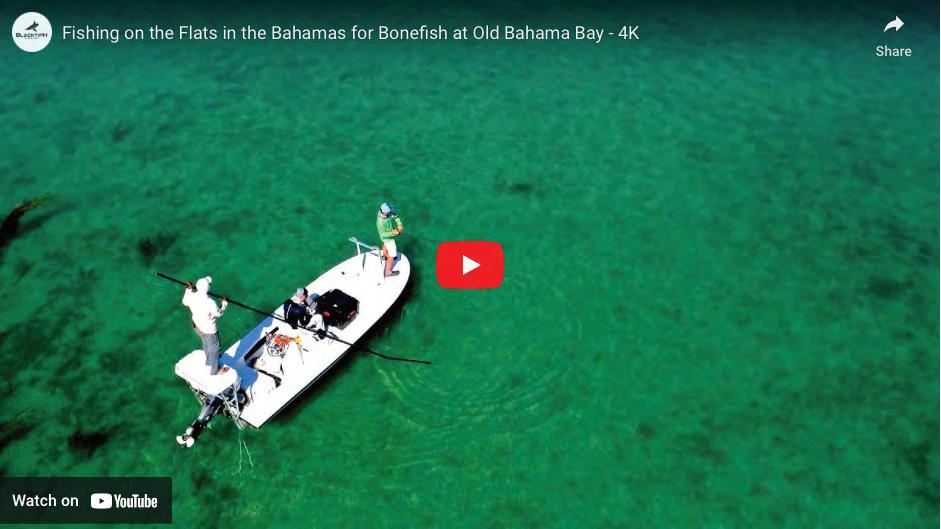
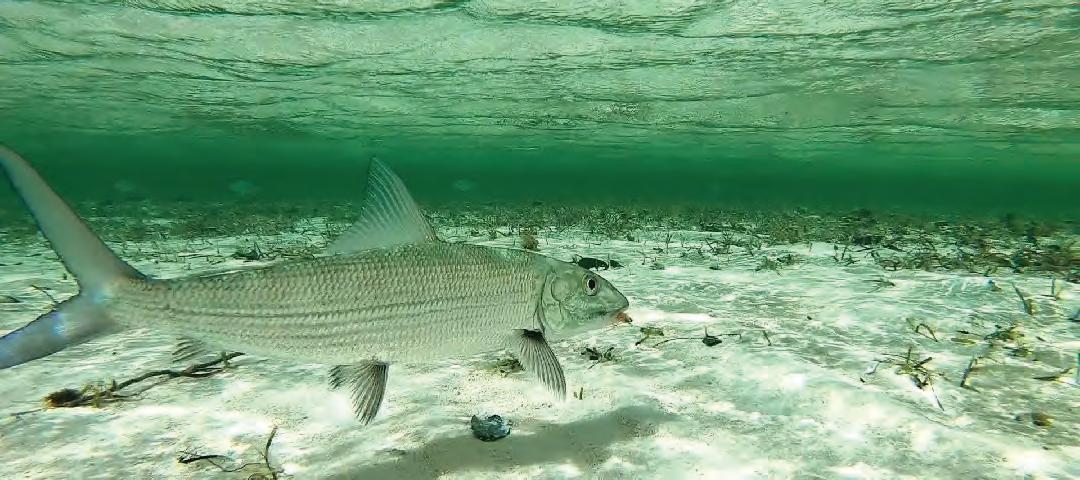
For more information on research progress, visit http://tomkarrow.wix.com/bahamas-guide-tek.

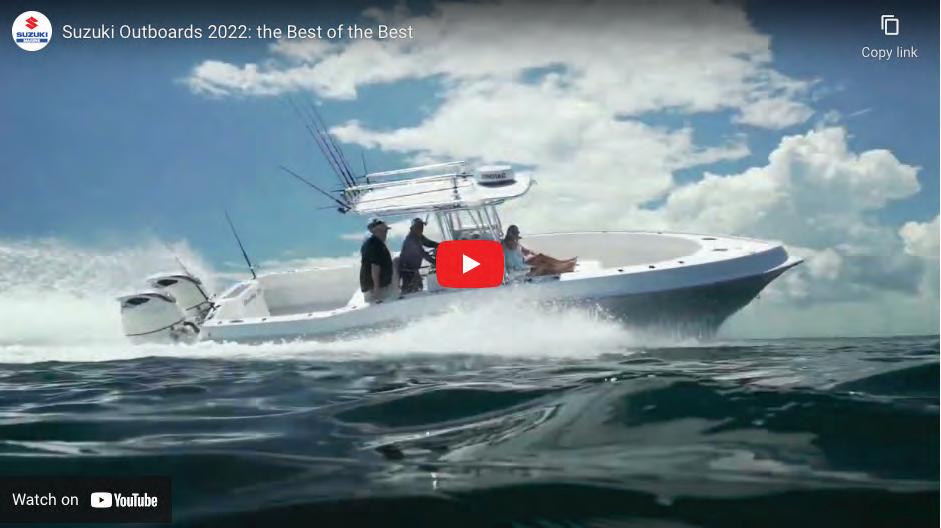
Suzuki Marine, USA LLC has launched two new additions to its powerful line-up of outboard motors — the new-for-2023 DF350AMD and DF300BMD V6 4-strokes. Suzuki Marine USA unveiled these new models today before the boating industry, press and boating public during the 2022 Fort Lauderdale International Boat Show.

“We’ve made these flagships of our fleet even better by adding some innovative new features that improve performance, durability and ease of rigging on a wide variety of boats,” said George “Gus” Blakely, Suzuki Marine Executive Vice President Sales & Service. “We listened to our boat building partners, our dealers and our customers and used their input to make our best motors even better. This has always been the Suzuki way,” added Blakely.
These 350 and 300 horsepower models with contra-rotating twin propellers are the first Suzuki outboards to offer the benefits of advanced integrated steering. Integrated steering allows for more streamlined rigging of these V6 outboards on a range of inshore, offshore and freshwater boats, while also providing a cleaner appearance in the motor well. Because integrated steering eliminates concerns about interference and clearance issues created by external steering cylinders, boat builders can more easily rig these popular outboards on a variety of hull types in single or multiple engine configurations. Integrated steering also reduces the possibility of the steering cylinder hitting the motor well if the outboard is tilted too far forward.
Suzuki has also engineered a new lower gear case for the DF350AMD and DF300BMD (also available on all five series 350A/300B models), designed to enhance durability, increase top-speed performance, improve fuel efficiency and make maintenance and service easier. The new design delivers superior gear lubrication and maintains the gear oil at a lower temperature, increasing durability and reliability over the long run — even in the toughest operating conditions.
The external surface area of this new gear case has also been reduced and reshaped, allowing the lower unit to slice through the water with less resistance. By doing this, Suzuki is able to deliver a marked improvement in both fuel efficiency and top-end performance for today’s boats. This streamlined gear case has the added benefit of reducing the amount of gear oil required from 3.2L to 2.8L. This new gear case also features a new oil passage that allows users to easily change the gear oil with Suzuki’s gear oil changer without having to lift the boat. This improvement will
make it easier for boaters to stay on top of scheduled maintenance and keep their new Suzuki’s running strong season after season. These new flagship models offer all the advanced technology and performance boaters expect from Suzuki’s popular DF350A and DF300B models (which will still be available in their original configuration). In addition to the proven performance and efficiency benefits of Suzuki’s dual-prop system, these motors boast a long list of features including a unique dual-louver air intake system, dual fuel injectors, variable valve timing, a self-adjusting timing chain, offset driveshaft design, Suzuki Lean Burn Technology, and more.
To learn more about the new DF350AMD and DF300BMD V6 4-strokes, or Suzuki Marine’s industry leading line-up of outboard motors from 2.5 to 350 horsepower, contact Suzuki Marine USA headquarters at (813) 687-7200 or visit www.suzukimarine.com.
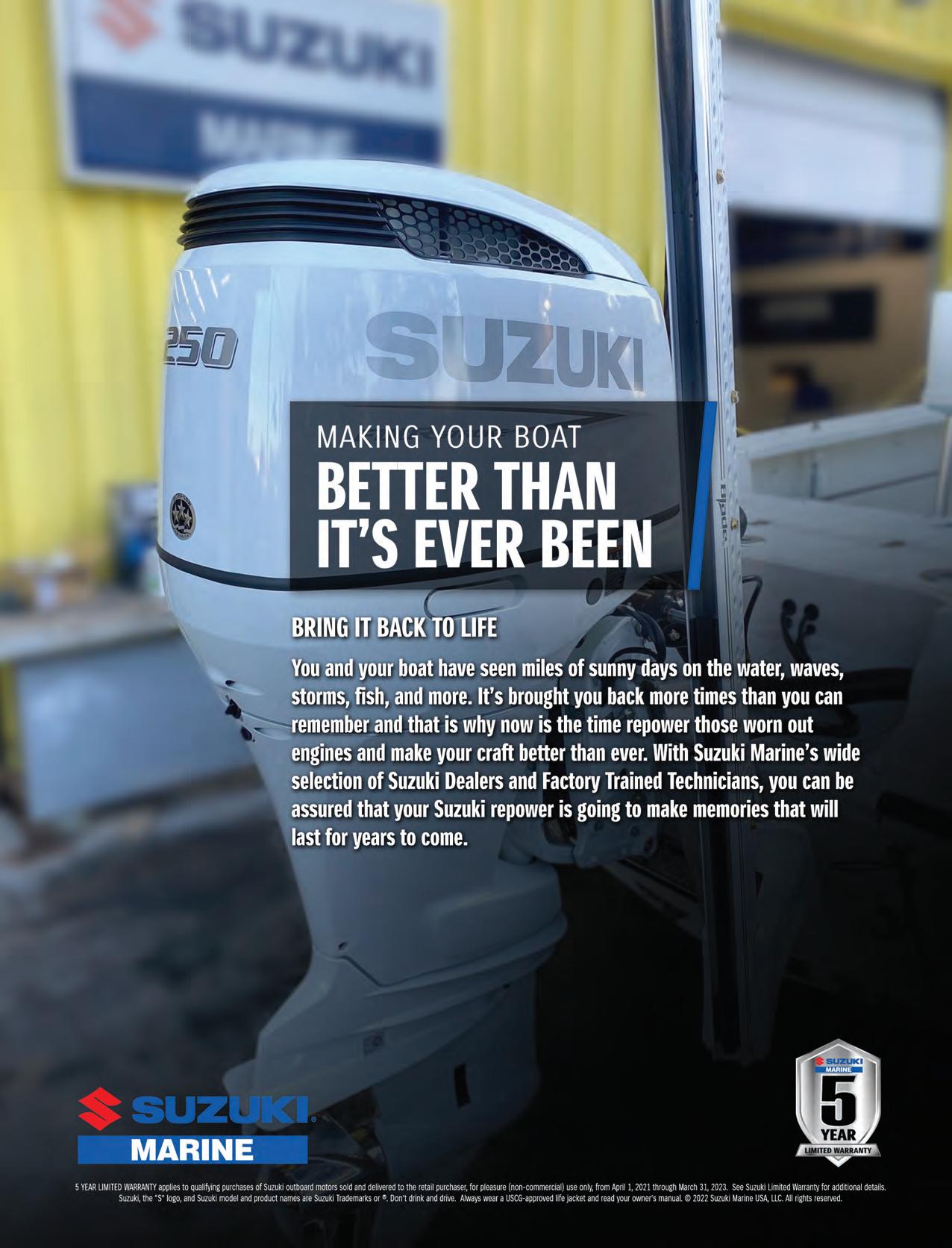
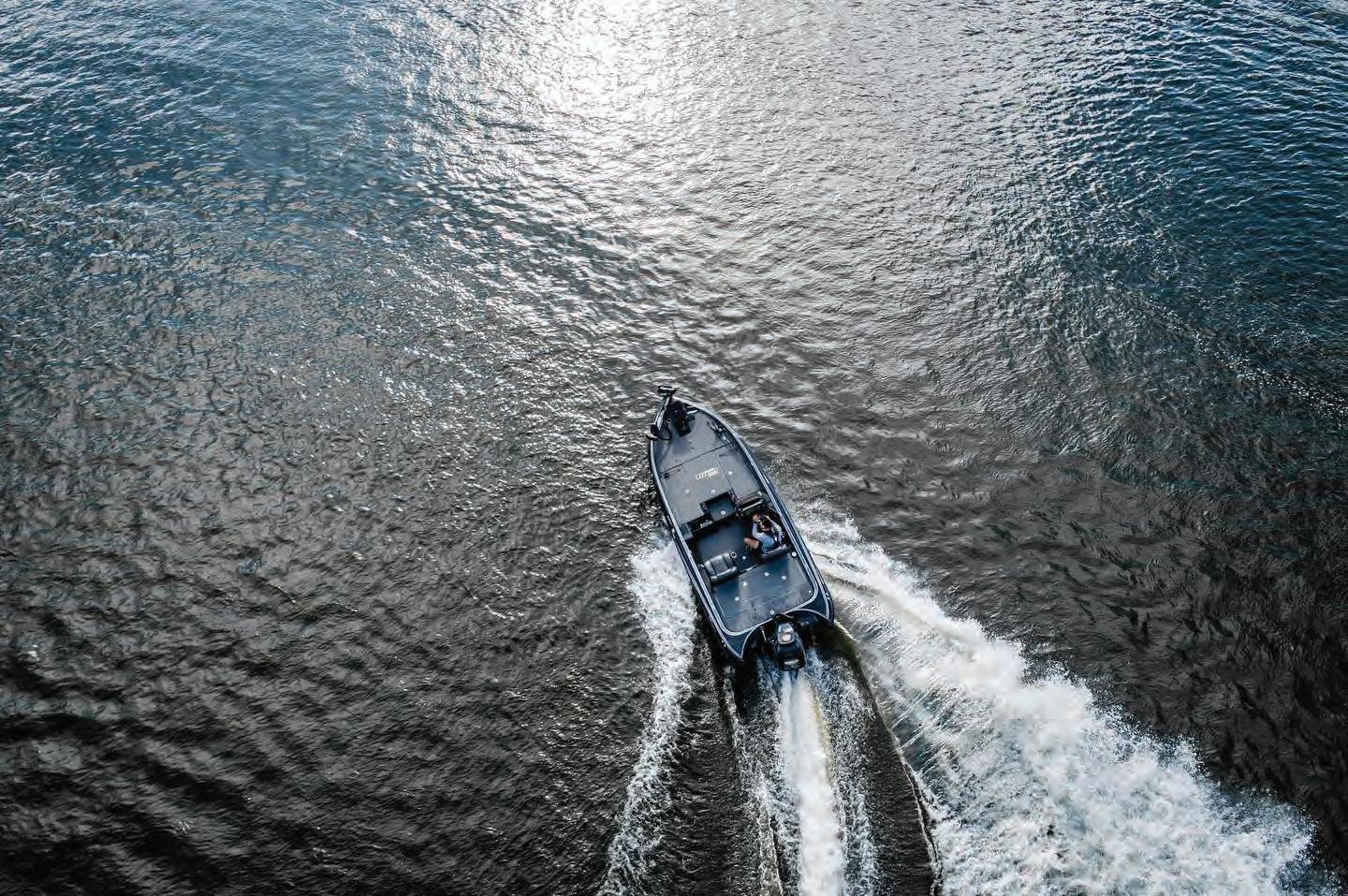


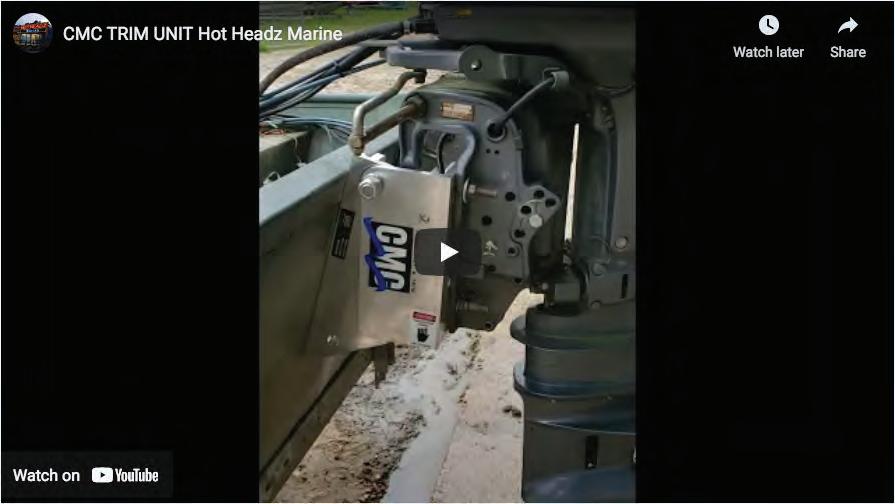
Anew women’s world record for tautog was caught out of Ocean City Maryland on Jan. 11. According to Daily Angle, the daily report from the website Fish in OC, Connecticut angler Jennifer Zuppe landed a 23.4-pound tautog, also known as blackfish, while fishing aboard Fish Bound with Capt. Kane Bounds.

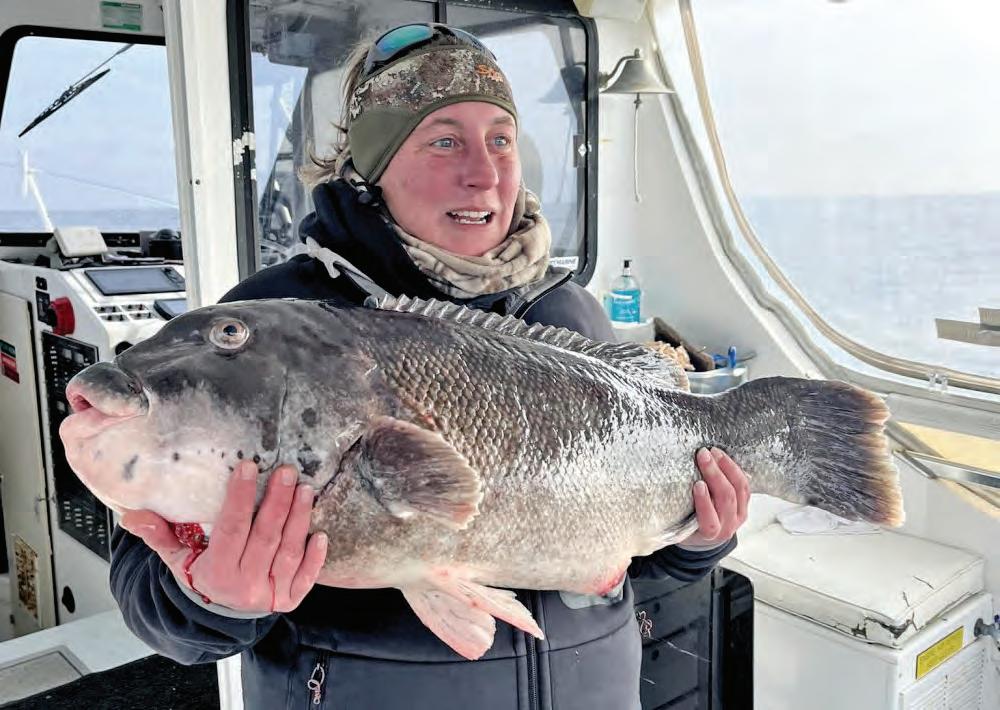
The Fish Bound already holds the IGFA all-tackle world record for tautog. In fact, Kenneth Westerfield, who caught the 28-pound, 13-ounce world record in 2015, was on board when Zuppe landed her fish, the Daily Angle reported.

Zuppe’s fish was weighed on IGFA scales, according to the Fish Bound Facebook page, and it will likely set a new women’s 30- or 50-pound line class record, as both of those categories are vacant in the IGFA record books.
Tautog, widely known as blackfish in the Mid-Atlantic, are bottom feeders that are popular sportfish of the Northeastern United States. They inhabit a depth range from 10 to 150 feet and are prized as table fare, like most species that have a diet of shellfish.
For more photos and to read the report, see https://fishinoc.com/




Yellowfin tuna are some of the most sought after gamefish in the world. They are the ahi tuna on the menus at restaurants and sushi bars, and in the water they have the speed and power to wear down anglers and break gear.
The signature “spiral” that tuna commence in the waning moments of a fight is responsible for untold numbers of broken lines and broken hearts. After battling 30 mph runs for 20 minutes or more, the weary angler, captain and crew face one final test, a team effort to survive the spiral and get the fish on deck. These tense moments, when a big yellowfin turns sideways and begins to circle, using its body’s mass as leverage, are the most critical minutes of the fight. If the line even touches the boat, it will snap, and the circling fish provides many opportunities for this to happen.
On chartered trips, the main limitation on the catch is the ability of the paying angler. The good news is there will likely be multiple opportunities on overnight trips to deep-water oil platforms off Texas. A great trip with six anglers would yield a dozen yellowfin tuna in the 40- to 120-pound range, and that doesn’t include the shots anglers will have at mahi-mahi, wahoo, marlin and blackfin tuna.
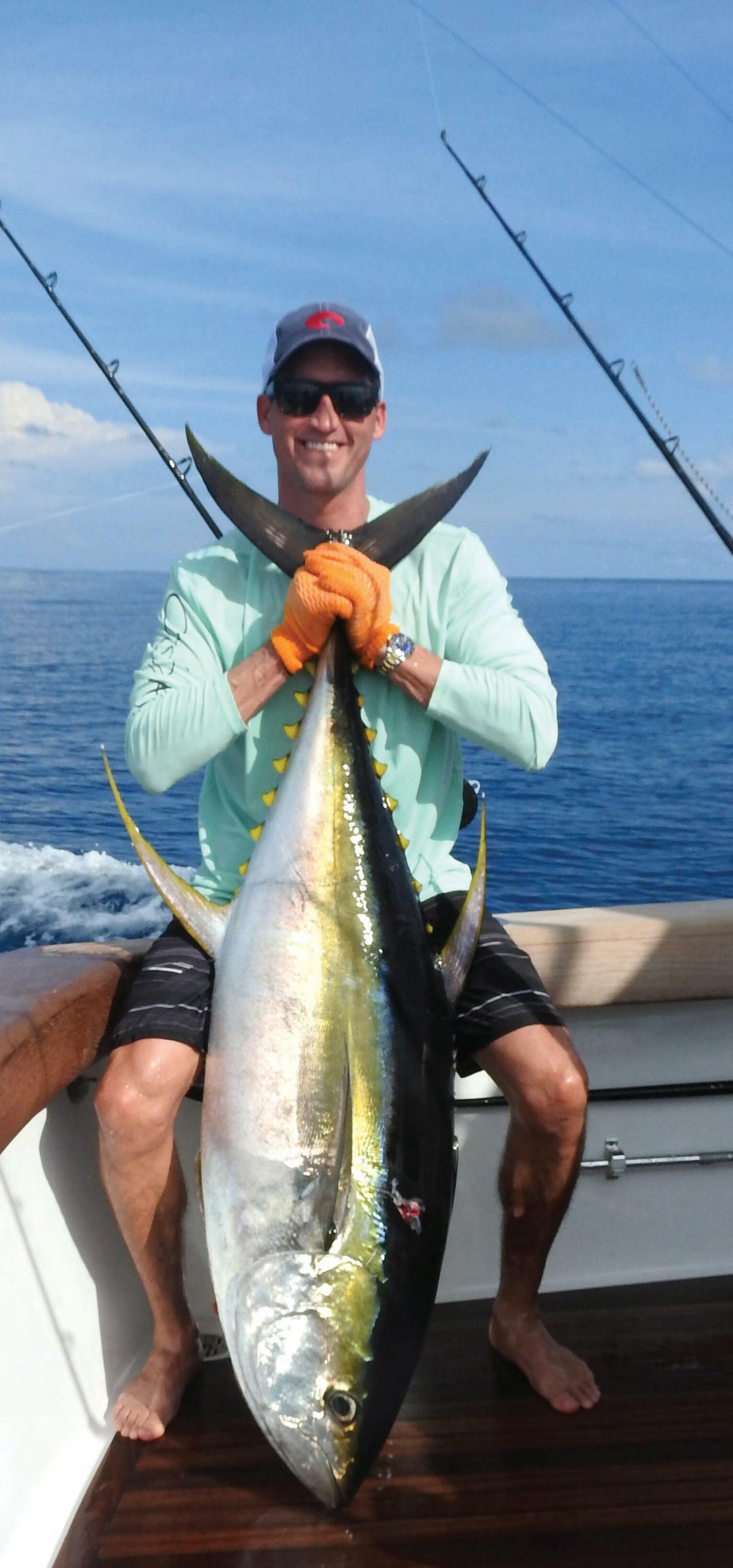
Out of Galveston, it’s 100 miles or more into the Gulf of Mexico to reach the enormous floating gas and oil structures off the edge of the Continental Shelf. These deep-water facilities, known as “floaters,” create their own food chain, consolidating bait and gamefish from miles around.
On a typical 36- or 48-hour trip, don’t plan on sleeping much. The floaters are brightly lit at night, which is when the tuna fishing is best. After identifying fish on the sonar, chumming and drift fishing with 30-pound-class tackle is usually the most productive method for yellowfin.
Sometimes the tuna will start breaching and leap into the air crashing bait like king mackerel. It’s for these occasions, when fish are on the surface, that big spinning rigs armed with poppers are kept on deck.
Drifting and pulling poppers while chugging back up-current to start a new drift goes on all night long. At dawn, the bait rods come in, and it’s time to start trolling. The primary daylight targets are marlin, sailfish, wahoo and dolphin.
Between night and day, it equates to a whole lot of big fish packed into a weekend at sea. It’s a grand adventure, and a meat trip of epic proportions in the Gulf of Mexico.
For more on big-game fishing in the Gulf of Mexico, see www.coastalanglermagazine.com.
smaller chicken dolphins. If lures are your thing I prefer Yozuri Crystal Minnows and honestly color doesn’t matter. Pitch around the weed lines or patches and look deeper down for the bigger Mahi. As for Tuna with all the chumming going on, I like to send down a vertical jig on 60#-80# test at least 100’ below the boat. Working your jig through the water column is a good way to fire up any kind of fish that may be lurking around in the shadows. If you have a large diamond jig I’d put some heavy wire in front of it for a chance at a wahoo. Triple Tail are amazing fish on light tackle and I recommend 15#-20# fluorocarbon and #2 Owner hook. Live
If bottom fishing is your go to joy Vermillion snappers, Groupers, and Rock salmon is my target. For Vermillion snappers I like using a 2-3 hook chicken rig mixed with cut squid and Boston mackerel. Let your weight sit right on the bottom and wait for those 2-3 light bites. Rock salmon and Groupers like to hide out in the rocks and caves, so a slip lead is what I like to use. Heavier leader line for Groupers and larger baits close to the bottom. Feel the bite and start cranking. The first 20’-30’ are the most

When it comes to offshore fishing don’t give up. There’s a lot of trial and error. Figure out what works best for you and as always keep your lines out and keep them tight.


